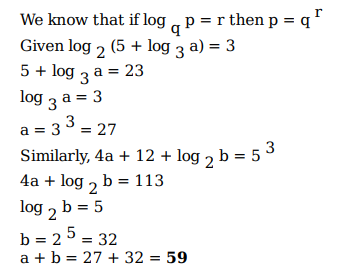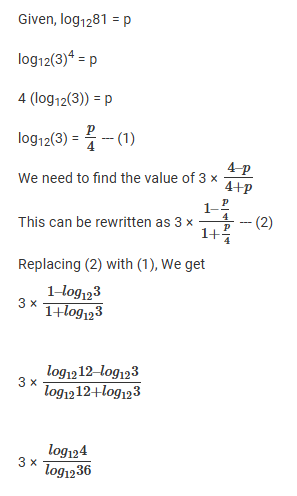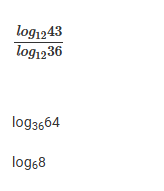Live Updates
• CATKing has launched new chat bot.

• New video on Logs has been released.
495
Learners
asked the doubt

Previous Year Questions
- Option 2 – See last paragraph: ‘elephants are suffering and behaving in the same ways that we recognize in ourselves as a result of violence ....’
- Option 3 – See paragraph 3: ‘young elephants are raised within an extended, multi-tiered network of doting female caregivers that includes the birth mother, grandmothers, aunts and friends. These relations are maintained over a life span as long as 70 years’
- Option 4 – See paragraph 4: ‘This fabric of elephant society, Bradshaw and her colleagues demonstrate, has effectively been frayed by years of habitat loss and poaching, along with systematic culling by government agencies’
The only thing worse than being lied to is not knowing you’re being lied to. It’s true that plastic pollution is a huge problem, of planetary proportions. And it’s true we could all do more to reduce our plastic footprint. The lie is that blame for the plastic problem is wasteful consumers and that changing our individual habits will fix it.
Recycling plastic is to saving the Earth what hammering a nail is to halting a falling skyscraper. You struggle to find a place to do it and feel pleased when you succeed. But your effort is wholly inadequate and distracts from the real problem of why the building is collapsing in the first place. The real problem is that single-use plastic—the very idea of producing plastic items like grocery bags, which we use for an average of 12 minutes but can persist in the environment for half a millennium—is an incredibly reckless abuse of technology. Encouraging individuals to recycle more will never solve the problem of a massive production of single-use plastic that should have been avoided in the first place.
As an ecologist and evolutionary biologist, I have had a disturbing window into the accumulating literature on the hazards of plastic pollution. Scientists have long recognized that plastics biodegrade slowly, if at all, and pose multiple threats to wildlife through entanglement and consumption. More recent reports highlight dangers posed by absorption of toxic chemicals in the water and by plastic odors that mimic some species’ natural food. Plastics also accumulate up the food chain, and studies now show that we are likely ingesting it ourselves in seafood. . . .
Beginning in the 1950s, big beverage companies like Coca-Cola and Anheuser-Busch, along with Phillip Morris and others, formed a non-profit called Keep America Beautiful. Its mission is/was to educate and encourage environmental stewardship in the public. . . . At face value, these efforts seem benevolent, but they obscure the real problem, which is the role that corporate polluters play in the plastic problem. This clever misdirection has led journalist and author Heather Rogers to describe Keep America Beautiful as the first corporate greenwashing front, as it has helped shift the public focus to consumer recycling behavior and actively thwarted legislation that would increase extended producer responsibility for waste management. . . . [T]he greatest success of Keep America Beautiful has been to shift the onus of environmental responsibility onto the public while simultaneously becoming a trusted name in the environmental movement. . . .
So what can we do to make responsible use of plastic a reality? First: reject the lie. Litterbugs are not responsible for the global ecological disaster of plastic. Humans can only function to the best of their abilities, given time, mental bandwidth and systemic constraints. Our huge problem with plastic is the result of a permissive legal framework that has allowed the uncontrolled rise of plastic pollution, despite clear evidence of the harm it causes to local communities and the world’s oceans. Recycling is also too hard in most parts of the U.S. and lacks the proper incentives to make it work well.
Which of the following interventions would the author most strongly support:
Video Explanation

Explanatory Answer
The central idea of the passage is that individuals are not responsible for the ecological disaster of plastic; the plastic problem is the result of a permissive legal framework that has not put the onus on producers of plastic to manage waste (see paragraphs 4 and 5). So, the intervention the author is likely to support is the one mentioned in option 4.
The author lists all of the following as negative effects of the use of plastics EXCEPT the:
Video Explanation

Explanatory Answer
Paragraph 3 lists options 1, 3 and 4 as the negative effects of the use of plastics. Only option 2 is not mentioned in the passage.
In the first paragraph, the author uses “lie” to refer to the:
Video Explanation

Explanatory Answer
Paragraph 1 clearly states that the lie ‘is that blame for the plastic problem is wasteful consumers and that changing our individual habits can fix it’.
In the second paragraph, the phrase “what hammering a nail is to halting a falling skyscraper” means:
Video Explanation

Explanatory Answer
In the second paragraph, the author compares consumers recycling plastic to save the Earth to ‘hammering a nail is to halting a falling skyscraper’. Note the line ‘encouraging individuals to recycle more will never solve the problem of a massive production of single-use plastic...’
It can be inferred that the author considers the Keep America Beautiful organisation:
Video Explanation

Explanatory Answer
See paragraph 4: ‘This clever misdirection .... Keep America Beautiful....the first corporate greenwashing front as it has helped shift the public focus to consumer recycling behavior and actively thwarted legislation that would increase extended producer responsibility for waste management’.
“Everybody pretty much agrees that the relationship between elephants and people has dramatically changed,” [says psychologist Gay] Bradshaw. “Where for centuries humans and elephants lived in relatively peaceful coexistence, there is now hostility and violence. Now, I use the term ‘violence’ because of the intentionality associated with it, both in the aggression of humans and, at times, the recently observed behavior of elephants.”
Typically, elephant researchers have cited, as a cause of aggression, the high levels of testosterone in newly matured male elephants or the competition for land and resources between elephants and humans. But, Bradshaw and several colleagues argue that today’s elephant populations are suffering from a form of chronic stress, a kind of species-wide trauma. Decades of poaching and culling and habitat loss, they claim, have so disrupted the intricate web of familial and societal relations by which young elephants have traditionally been raised in the wild, and by which established elephant herds are governed, that what we are now witnessing is nothing less than a precipitous collapse of elephant culture.
Elephants, when left to their own devices, are profoundly social creatures. young elephants are raised within an extended, multi-tiered network of doting female caregivers that includes the birth mother, grandmothers, aunts and friends. These relations are maintained over a life span as long as 70 years. Studies of established herds have shown that young elephants stay within 15 feet of their mothers for nearly all of their first eight years of life, after which young females are socialized into the matriarchal network, while young males go off for a time into an all-male social group before coming back into the fold as mature adults.
This fabric of elephant society, Bradshaw and her colleagues [demonstrate], ha[s] effectively been frayed by years of habitat loss and poaching, along with systematic culling by government agencies to control elephant numbers and translocations of herds to different habitats. As a result of such social upheaval, calves are now being born to and raised by ever younger and inexperienced mothers. Young orphaned elephants, meanwhile, that have witnessed the death of a parent at the hands of poachers are coming of age in the absence of the support system that defines traditional elephant life. “The loss of elephant elders,” [says] Bradshaw "and the traumatic experience of witnessing the massacres of their family, impairs normal brain and behavior development in young elephants.”
What Bradshaw and her colleagues describe would seem to be an extreme form of anthropocentric conjecture if the evidence that they’ve compiled from various elephant researchers weren’t so compelling. The elephants of decimated herds, especially orphans who’ve watched the death of their parents and elders from poaching and culling, exhibit behavior typically associated with post-traumatic stress disorder and other trauma-related disorders in humans: abnormal startle response, unpredictable asocial behavior, inattentive mothering and hyper-aggression.
[According to Bradshaw], “Elephants are suffering and behaving in the same ways that we recognize in ourselves as a result of violence. Except perhaps for a few specific features, brain organization and early development of elephants and humans are extremely similar.”
Which of the following statements best expresses the overall argument of this passage?
Video Explanation

Explanatory Answer
While all given options are true statements, the overall argument of the passage is best captured by option 3. As against the typical explanation offered by researchers for elephant aggression (high levels of testosterone, competition for land and resources etc) Bradshaw and her colleagues argue that chronic stress is the reason for elephant behavior observed today. The passage explains the reasons for this stress in detail.
In the first paragraph, Bradshaw uses the term "violence" to describe the recent change in the human-elephant relationship because, according to him:
Video Explanation

Explanatory Answer
Easy one. The first paragraph clearly states ‘I use the term violence because of the intentionality associated with it...’
The passage makes all of the following claims EXCEPT
Video Explanation

Explanatory Answer
While there is no evidence in the passage to support option 1, the other options can be defended by statements in the passage:
Which of the following measures is Bradshaw most likely to support to address the problem of elephant aggression?
Video Explanation

Explanatory Answer
The key idea of the passage is that the chronic stress elephants experience due to human activities like poaching and culling is the reason why there is hostility and violence between humans and elephants. So, to address the problem of elephant aggression, Bradshaw is likely to support a measure that helps reduce or overcome this stress. Option 1 offers a possible solution.
Bradshaw does not believe testosterone is the reason for elephant aggression; so, option 2 is ruled out.
Neither option 3 nor 4 is compelling as they do not address the problem of elephant aggression. Besides, Bradshaw has already documented evidence to show that isolating elephant calves impacts their development and behavior and that humans and elephants are similar in brain organization and early development.
In paragraph 4, the phrase, “The fabric of elephant society . . . has(s) effectively been frayed by . . .” is:
Video Explanation

Explanatory Answer
The fabric of elephant society ... has effectively been frayed...
Here, the elephant society is compared to a frayed fabric. This is a metaphor, a figure of speech used to explain an idea by equating it to something else.
The Indian government has announced an international competition to design a National War Memorial in New Delhi, to honour all of the Indian soldiers who served in the various wars and counter-insurgency campaigns from 1947 onwards. The terms of the competition also specified that the new structure would be built adjacent to the India Gate – a memorial to the Indian soldiers who died in the First World War. Between the old imperialist memorial and the proposed nationalist one, India’s contribution to the Second World War is airbrushed out of existence.
The Indian government’s conception of the war memorial was not merely absentminded. Rather, it accurately reflected the fact that both academic history and popular memory have yet to come to terms with India’s Second World War, which continues to be seen as little more than mood music in the drama of India’s advance towards independence and partition in 1947. Further, the political trajectory of the postwar subcontinent has militated against popular remembrance of the war. With partition and the onset of the India-Pakistan rivalry, both of the new nations needed fresh stories for self-legitimisation rather than focusing on shared wartime experiences.
However, the Second World War played a crucial role in both the independence and partition of India. The Indian army recruited, trained and deployed some 2.5 million men, almost 90,000 of which were killed and many more injured. Even at the time, it was recognised as the largest volunteer force in the war.
India’s material and financial contribution to the war was equally significant. India emerged as a major military-industrial and logistical base for Allied operations in south-east Asia and the Middle East. This led the United States to take considerable interest in the country’s future, and ensured that this was no longer the preserve of the British government. Other wartime developments pointed in the direction of India’s independence. In a stunning reversal of its long-standing financial relationship with Britain, India finished the war as one of the largest creditors to the imperial power.
Such extraordinary mobilization for war was achieved at great human cost, with the Bengal famine the most extreme manifestation of widespread wartime deprivation. The costs on India’s home front must be counted in millions of lives.
Indians signed up to serve on the war and home fronts for a variety of reasons. Many were convinced that their contribution would open the doors to India’s freedom. The political and social churn triggered by the war was evident in the massive waves of popular protest and unrest that washed over rural and urban India in the aftermath of the conflict. This turmoil was crucial in persuading the Attlee government to rid itself of the incubus of ruling India. Seventy years on, it is time that India engaged with the complex legacies of the Second World War. Bringing the war into the ambit of the new national memorial would be a fitting – if not overdue – recognition that this was India’s War.
In the first paragraph, the author laments the fact that
Video Explanation

Explanatory Answer
In the first paragraph, the author deplores the fact that ‘India’s contribution to the second world war is airbrushed out of existence.’ That is, there is no recognition of the Indian soldiers who served in the second world war.
The author lists all of the following as outcomes of the Second World War EXCEPT:
Video Explanation

Explanatory Answer
Option 4 is clearly incorrect, as the passage states that ‘ India finished the war as one of the largest creditors’ to Britain in the second world war. (see paragraph 5).
Evidence to support option 1 is in paragraph 4. That the Bengal famine was one of the dreadful outcomes of the war is explained in paragraph 6. Evidence to support option 3 is in paragraph 7.
The phrase “mood music” is used in the second paragraph to indicate that the Second World War is viewed as:
Video Explanation

Explanatory Answer
The author says ‘India’s second world war... continues to be seen as little more than mood music in the drama of India’s advance towards independence and partition in 1947.’ That is, the war is seen as nothing more than a background score/ backdrop that sets the mood in the drama leading to independence and partition.
The author suggests that a major reason why India has not so far acknowledged its role in the Second World War is that it:
Video Explanation

Explanatory Answer
See paragraph 2: The author states that ‘the political trajectory of the postwar subcontinent has militated against popular remembrance of the war...’ as both nations needed ‘fresh stories for self-legitimization rather than focusing on shared wartime experiences’. That is, rather than looking into shared wartime experiences with Pakistan, India focused on building an independent, non-colonial political identity after independence.
There is no evidence in the paragraph to support any of the other options.
The author claims that omitting mention of Indians who served in the Second World War from the new National War Memorial is:
Video Explanation

Explanatory Answer
In the second paragraph, the author clearly states that the reason why the new war memorial is conceived the way it is can be attributed to the fact that ‘both academic history and popular memory have yet to come to terms with India’s second world war’.
Economists have spent most of the 20th century ignoring psychology, positive or otherwise. But today there is a great deal of emphasis on how happiness can shape global economies, or — on a smaller scale — successful business practice. This is driven, in part, by a trend in "measuring" positive emotions, mostly so they can be optimized. Neuroscientists, for example, claim to be able to locate specific emotions, such as happiness or disappointment, in particular areas of the brain. Wearable technologies, such as Spire, offer data-driven advice on how to reduce stress.
We are no longer just dealing with "happiness" in a philosophical or romantic sense — it has become something that can be monitored and measured, including by our behavior, use of social media and bodily indicators such as pulse rate and facial expressions. There is nothing automatically sinister about this trend. But it is disquieting that the businesses and experts driving the quantification of happiness claim to have our best interests at heart, often concealing their own agendas in the process. In the workplace, happy workers are viewed as a "win-win." Work becomes more pleasant, and employees, more productive. But this is now being pursued through the use of performance-evaluating wearable technology, such as Humanyze or Virgin Pulse, both of which monitor physical signs of stress and activity toward the goal of increasing productivity.
Cities such as Dubai, which has pledged to become the "happiest city in the world," dream up ever-more elaborate and intrusive ways of collecting data on well-being — to the point where there is now talk of using CCTV cameras to monitor facial expressions in public spaces. New ways of detecting emotions are hitting the market all the time: One company, Beyond Verbal, aims to calculate moods conveyed in a phone conversation, potentially without the knowledge of at least one of the participants. And Facebook [has] demonstrated that it could influence our emotions through tweaking our news feeds — opening the door to ever-more targeted manipulation in advertising and influence.
As the science grows more sophisticated and technologies become more intimate with our thoughts and bodies, a clear trend is emerging. Where happiness indicators were once used as a basis to reform society, challenging the obsession with money that G.D.P. measurement entrenches, they are increasingly used as a basis to transform or discipline individuals.
Happiness becomes a personal project, that each of us must now work on, like going to the gym. Since the 1970s, depression has come to be viewed as a cognitive or neurological defect in the individual, and never a consequence of circumstances. All of this simply escalates the sense of responsibility each of us feels for our own feelings, and with it, the sense of failure when things go badly. A society that deliberately removed certain sources of misery, such as precarious and exploitative employment, may well be a happier one. But we won't get there by making this single, often fleeting emotion, the over-arching goal.
According to the author, wearable technologies and social media are contributing most to:
Video Explanation

Explanatory Answer
Close contest between options 3 and 4 here. The first paragraph says that ‘wearable technologies... offer data-driven advice on how to reduce stress’ and the third paragraph that ‘performance evaluating wearable technology... monitor physical signs of stress and activity toward the goal of increasing productivity’.
The main idea of the passage is that happiness is being quantified by businesses—ostensibly with our best interests in heart—but, in reality used as ‘a basis to transform or discipline individuals’. This is best reflected by option 3
The author’s view would be undermined by which of the following research findings?
Video Explanation

Explanatory Answer
The very premise of the passage is that, increasingly, individual data is being collected in ever-more elaborate and intrusive ways and that this data is being used to manipulate or transform individuals. Options 1, 3 and 4 support this. Only 2 does not.
According to the author, Dubai:
Video Explanation

Explanatory Answer
See the fourth paragraph: ‘Dubai.... ever-more elaborate and intrusive ways of collecting data on well-being - to the point where there is now talk of using CCTV cameras to monitor facial expressions in public spaces.’
In the author's opinion, the shift in thinking in the 1970s:
Video Explanation

Explanatory Answer
See the last paragraph: ‘Since the 1970s, depression has come to be viewed as a cognitive or neurological defect in the individual, and never a consequence of circumstances. All of this simply escalates the sense of responsibility each of us feels for our own feelings, and with it, the sense of failure when things go badly.’
From the passage we can infer that the author would like economists to:
Video Explanation

Explanatory Answer
In the first paragraph, the author states that while economists ignored psychology for the most part of the 20th century, today they put a great deal of emphasis on how happiness can shape economies and businesses. The author then goes on to say why the current trend of quantification of happiness is ‘disquieting’. We infer that the author would recommend a middle path.
Option 2 is clearly incorrect: See the reference to ‘the obsession with money that GDP measurement entrenches’ in paragraph 5. Neither option 3 nor option 4 is mentioned in the paragraph.
When researchers at Emory University in Atlanta trained mice to fear the smell of almonds (by pairing it with electric shocks), they found, to their consternation, that both the children and grandchildren of these mice were spontaneously afraid of the same smell. That is not supposed to happen. Generations of schoolchildren have been taught that the inheritance of acquired characteristics is impossible. A mouse should not be born with something its parents have learned during their lifetimes, any more than a mouse that loses its tail in an accident should give birth to tailless mice.
Modern evolutionary biology dates back to a synthesis that emerged around the 1940s60s, which married Charles Darwin’s mechanism of natural selection with Gregor Mendel’s discoveries of how genes are inherited. The traditional, and still dominant, view is that adaptations – from the human brain to the peacock’s tail – are fully and satisfactorily explained by natural selection (and subsequent inheritance). Yet [new evidence] from genomics, epigenetics and developmental biology [indicates] that evolution is more complex than we once assumed.
In his book On Human Nature (1978), the evolutionary biologist Edward O Wilson claimed that human culture is held on a genetic leash. The metaphor [needs revision]. Imagine a dogwalker (the genes) struggling to retain control of a brawny mastiff (human culture). The pair’s trajectory (the pathway of evolution) reflects the outcome of the struggle. Now imagine the same dog-walker struggling with multiple dogs, on leashes of varied lengths, with each dog tugging in different directions. All these tugs represent the influence of developmental factors, including epigenetics, antibodies and hormones passed on by parents, as well as the ecological legacies and culture they bequeath.
The received wisdom is that parental experiences can’t affect the characters of their offspring. Except they do. The way that genes are expressed to produce an organism’s phenotype– the actual characteristics it ends up with – is affected by chemicals that attach to them. Everything from diet to air pollution to parental behaviour can influence the addition or removal of these chemical marks, which switches genes on or off. Usually these so-called ‘epigenetic’ attachments are removed during the production of sperm and eggs cells, but it turns out that some escape the resetting process and are passed on to the next generation, along with the genes. This is known as ‘epigenetic inheritance’, and more and more studies are confirming that it really happens. Let’s return to the almond-fearing mice. The inheritance of an epigenetic mark transmitted in the sperm is what led the mice’s offspring to acquire an inherited fear.
Epigenetics is only part of the story. Through culture and society, [humans and other animals] inherit knowledge and skills acquired by [their] parents. All this complexity points to an evolutionary process in which genomes (over hundreds to thousands of generations), epigenetic modifications and inherited cultural factors (over several, perhaps tens or hundreds of generations), and parental effects (over single-generation timespans) collectively informb how organisms adapt. These extra-genetic kinds of inheritance give organisms the flexibility to make rapid adjustments to environmental challenges, dragging genetic change in their wake – much like a rowdy pack of dogs.
The passage uses the metaphor of a dog walker to argue that evolutionary adaptation is most comprehensively understood as being determined by:
Video Explanation

Explanatory Answer
Answer to this question is in paragraphs 3 and 5. The last paragraph states that genomes, epigenetic modifications, inherited cultural factors and parental effects affect evolutionary adaption. Paragraph 3 groups epigenetics and parental effects under ‘developmental factors’ and also mentions ecological legacies. Option 1 covers all these influences comprehensively.
Which of the following options best describes the author's argument?
Video Explanation

Explanatory Answer
See the second paragraph: ‘The traditional, and still dominant, view is that adaptations ...are fully and satisfactorily explained by natural selection and subsequent inheritance. Yet new evidence from genomics, epigenetics and developmental biology indicates that evolution is more complex than we once assumed ...’.
Options 2 and 3 are clearly incorrect. There is no evidence in the passage to support the claim that Wilsons theory of evolution is scientifically superior to Darwin’s or Mendel’s.
The Emory University experiment with mice points to the inheritance of:
Video Explanation

Explanatory Answer
See paragraph 1: ‘That is not supposed to happen. Generations of schoolchildren have been taught that the inheritance of acquired characteristics is impossible...’ Option 4 is incorrect as it is too narrow in scope, talking only of acquired parental fears.
Which of the following, if found to be true, would negate the main message of the passage?
Video Explanation

Explanatory Answer
The main idea of the passage is that evolution is shaped by several factors—genomics, epigenetics and developmental biology—and cannot be fully and satisfactorily explained by natural selection and subsequent inheritance alone. Options 1, 2 and 4 would support this. Only option 3 negates the main idea of the passage.
The four sentences (labelled 1, 2, 3, 4) given below, when properly sequenced would yield a coherent paragraph. Decide on the proper sequence of the order of the sentences and key in the sequence of the four numbers as your answer.
1. Impartiality and objectivity are fiendishly difficult concepts that can cause all sorts of injustices even if transparently implemented.
2. It encourages us into bubbles of people we know and like, while blinding us to different perspectives, but the deeper problem of ‘transparency’ lies in the words “and much more”.
3. Twitter’s website says that “tweets you are likely to care about most will show up first in your timeline based on accounts you interact with most, tweets you engage with, and much more.”
4. We are only told some of the basic principles, and we can’t see the algorithm itself, making it hard for citizens to analyse the system sensibly or fairly or be convinced of its impartiality and objectivity
Video Explanation

Explanatory Answer
324 is a clear sequence: all three sentences are about Twitter’s policy. 2 follows immediately after 3, as the pronoun ‘it’ that 2 starts with could only refer to the statement in Twitter’s website mentioned in 3.
The four sentences (labelled 1, 2, 3, 4) given below, when properly sequenced would yield a coherent paragraph. Decide on the proper sequence of the order of the sentences and key in the sequence of the four numbers as your answer.
1. The eventual diagnosis was skin cancer and after treatment all seemed well.
2. The viola player didn’t know what it was; nor did her GP
3. Then a routine scan showed it had come back and spread to her lungs.
4. It started with a lump on Cathy Perkins’ index finger.
Video Explanation

Explanatory Answer
Sentence 4 is the best opening sentence: it sets the scene and tells us what ‘it started with’. The subject of sentence 2 is ‘the viola player’. This could only be Cathy Perkins, who is mentioned only in 4. So, 2 follows immediately after 4. Now, of the remaining sentences, 1 is a better option to follow 2 than 3. This is because sentences 2 and 4 talk of a medical condition. Sentence 1 mentions the ‘eventual diagnosis’ and response to treatment. So, 1 follows 2. Also, sentence 3 states that ‘it had come back’. The ‘it’ in question could only refer to the cancer mentioned in 1. So, 3 follows 1.
The four sentences (labelled 1, 2, 3, 4) given below, when properly sequenced would yield a coherent paragraph. Decide on the proper sequence of the order of the sentences and key in the sequence of the four numbers as your answer.
1. The woodland’s canopy receives most of the sunlight that falls on the trees.
2. Swifts do not confine themselves to woodlands, but hunt wherever there are insects in the air.
3. With their streamlined bodies, swifts are agile flyers, ideally adapted to twisting and turning through the air as they chase flying insects – the creatures that form their staple diet.
4. Hundreds of thousands of insects fly in the sunshine up above the canopy, some falling prey to swifts and swallows.
Video Explanation

Explanatory Answer
Sentence 1 is the best opening sentence. 14 is a link due to the reference to ‘the canopy’ in 4. Both sentences 2 and 3 talk about swifts chasing insects. However, the order 32 is better than 23 because sentence 3 explains that insects are the creatures that form the staple diet of swifts. Sentence 2, which states that swifts hunt ‘wherever there are insects in the air’ can only follow 3.
The four sentences (labelled 1, 2, 3, 4) given below, when properly sequenced would yield a coherent paragraph. Decide on the proper sequence of the order of the sentences and key in the sequence of the four numbers as your answer.
1. But now we have another group: the unwitting enablers.
2. Democracy and high levels of inequality of the kind that have come to characterize the United States are simply incompatible.
3. Believing these people are working for a better world, they are, actually, at most, chipping away at the margins, making slight course corrections, ensuring the system goes on as it is, uninterrupted.
4. Very rich people will always use money to maintain their political and economic power.
Video Explanation

Explanatory Answer
Sentence 2 is the best opening sentence, as it is very general. 4 explains 2 and so 24 is a sequence. Similarly, 41 is a sequence: 4 talks of ‘very rich people’ as a group, while sentence 1 talks of ‘another group’, the unwitting enablers. The reference to ‘these people’ in 3 could only be to the unwitting enablers. So, 3 is the concluding sentence.
The passage given below is followed by four alternate summaries. Choose the option that best captures the author's position
Artificial embryo twinning is a relatively low-tech way to make clones. As the name suggests, this technique mimics the natural process that creates identical twins. In nature, twins form very early in development when the embryo splits in two. Twinning happens in the first days after egg and sperm join, while the embryo is made of just a small number of unspecialized cells. Each half of the embryo continues dividing on its own, ultimately developing into separate, complete individuals. Since they developed from the same fertilized egg, the resulting individuals are genetically identical.
Video Explanation

Explanatory Answer
The paragraph states that artificial embryo twinning is relatively low-tech and that it mimics the natural twinning process, where in the first days after fertilization, the embryo splits into two genetically identical individuals. Option 1 simply rephrases this.
Option 3 is clearly incorrect, as it states that artificial embryo twinning is unlike natural twinning. Option 2 is incorrect, as it states that twins are formed during fertilization. Option 4 is a bit vague and not as precise as option 1.
The passage given below is followed by four alternate summaries. Choose the option that best captures the author's position
Production and legitimation of scientific knowledge can be approached from a number of perspectives. To study knowledge production from the sociology of professions perspective would mean a focus on the institutionalization of a body of knowledge. The professions-approach informed earlier research on managerial occupation, business schools and management knowledge. It however tends to reify institutional power structures in its understanding of the links between knowledge and authority. Knowledge production is restricted in the perspective to the selected members of the professional community, most notably to the university faculties and professional colleges. Power is understood as a negative mechanism, which prevents the nonprofessional actors from offering their ideas and information as legitimate knowledge.
Video Explanation

Explanatory Answer
Option 3 sums up all the key ideas in the paragraph: 'To study knowledge production from....professions perspective would mean a focus on the institutionalization of a body of knowledge... however tends to reify institutional power structures...knowledge production is restricted in the perspective to the selected members of the professional community'.
Option 1 rephrases the first line of the paragraph; it does not summarize the paragraph. Option 3 calls the professions approach ‘one of the most relied upon perspective in the study of management knowledge production’. There is no evidence in the paragraph to support this. Option 4 is also not supported by the paragraph. The paragraph only states that the professions approach researches managerial occupation, business schools and management knowledge. It does not talk of the creation of institutions of higher education and disciplines.
The passage given below is followed by four alternate summaries. Choose the option that best captures the author's position
The conceptualization of landscape as a geometric object first occurred in Europe and is historically related to the European conceptualization of the organism, particularly the human body, as a geometric object with parts having a rational, three-dimensional organization and integration. The European idea of landscape appeared before the science of landscape emerged, and it is no coincidence that Renaissance artists such as Leonardo da Vinci, who studied the structure of the human body, also facilitated an understanding of the structure of landscape. Landscape which had been a subordinate background to religious or historical narratives, became an independent genre or subject of art by the end of sixteenth century or the beginning of the seventeenth century.
Video Explanation

Explanatory Answer
The main idea of this paragraph is that the conceptualization and study of landscape as a geometric object by Renaissance artists led to it being recognized as an independent genre/subject of art by the end of the 16th century. Of the given options, option 1 captures this idea best.
Option 2 is close. The paragraph does talk of the 3D understanding of the organism/human body facilitating the understanding of the structure of the landscape. However, the focus of the given paragraph is on the study of landscape by Renaissance artists and how it evolved to become an independent genre/ subject of art by the end of the sixteenth century. Option 2 focuses on one, narrow idea and is not as good a summary as option 1. In the same way, option 3 focuses on Renaissance artists, calling them “responsible” for the study of landscape as a subject of art. The paragraph only states that they facilitated an understanding of the structure of landscape. Option 4, while correct, does not mention Renaissance artists.
Five sentences related to a topic are given below. Four of them can be put together to form a meaningful and coherent short paragraph. Identify the odd one out. Choose its number as your answer and key it in.
1. Displacement in Bengal is thus not very significant in view of its magnitude.
2. A factor of displacement in Bengal is the shifting course of the Ganges leading to erosion of river banks.
3. The nature of displacement in Bengal makes it an interesting case study.”
4. Since displacement due to erosion is well spread over a long period of time, it remains invisible.
5. Rapid displacement would have helped sensitize the public to its human costs.
Video Explanation

Explanatory Answer
Of the given sentences, only 5 talks of rapid displacement and sensitizing the public to the human cost of displacement. None of the other sentences relate to these ideas.
Five sentences related to a topic are given below. Four of them can be put together to form a meaningful and coherent short paragraph. Identify the odd one out. Choose its number as your answer and key it in.
1. In many cases time inconsistency is what prevents our going from intention to action.
2. For people to continuously postpone getting their children immunized, they would need to be constantly fooled by themselves.
3. In the specific case of immunization, however, it is hard to believe that time inconsistency by itself would be sufficient to make people permanently postpone the decision if they were fully cognizant of its benefits.
4. In most cases, even a small cost of immunization was large enough to discourage most people.
5. Not only do they have to think that they prefer to spend time going to the camp next month rather than today, they also have to believe that they will indeed go next month.
Video Explanation

Explanatory Answer
Only 4 cites the cost of immunization as a factor in discouraging people from immunization. The rest of the sentences are about the logic for constant postponement of immunization. The sequence 1325 is a cogent paragraph.
Five sentences related to a topic are given below. Four of them can be put together to form a meaningful and coherent short paragraph. Identify the odd one out. Choose its number as your answer and key it in.
1. Translators are like bumblebees.
2. Though long since scientifically disproved, this factoid is still routinely trotted out.
3. Similar pronouncements about the impossibility of translation have dogged practitioners since Leonardo Bruni’s De interpretatione recta, published in 1424.
4. Bees, unaware of these deliberations, have continued to flit from flower to flower, and translators continue to translate.
5. In 1934, the French entomologist August Magnan pronounced the flight of the bumblebee to be aerodynamically impossible
Video Explanation

Explanatory Answer
1 and 4 liken translators to bumblebees. Also, 53 is a sequence: 5 about the impossibility of the flight of the bumblebee and 3 about the impossibility of translation. While 2 could fit into the paragraph after 5, if an odd sentence is to be picked, the best choice is 2.

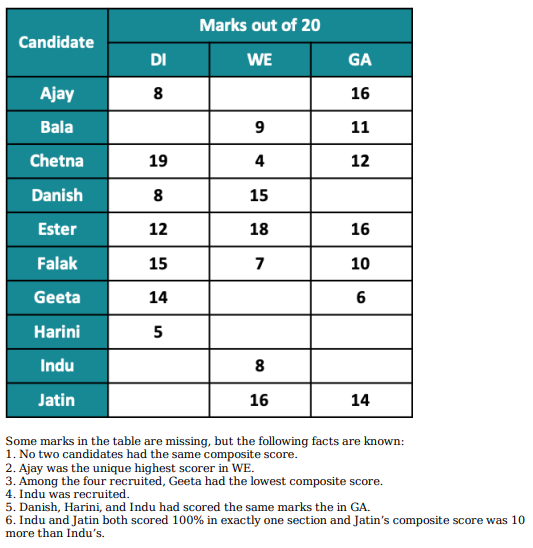
Which of the following statements MUST be true?
1.Jatin's composite score was more than that of Danish.
2. Indu scored less than Chetna in DI.
3. Jatin scored more than Indu in GA.
Video Explanation

Explanatory Answer
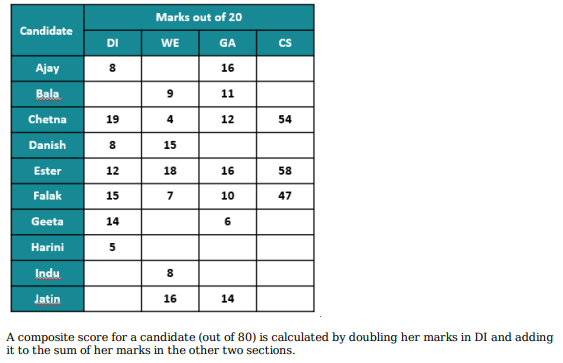
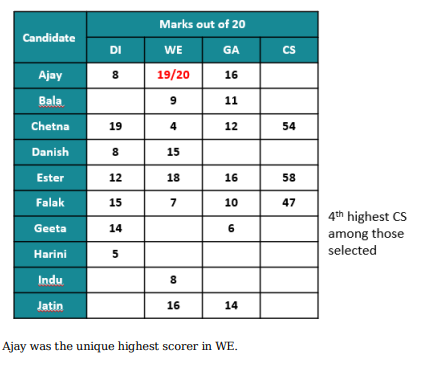
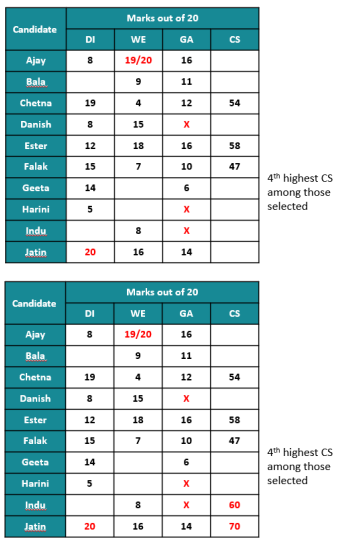
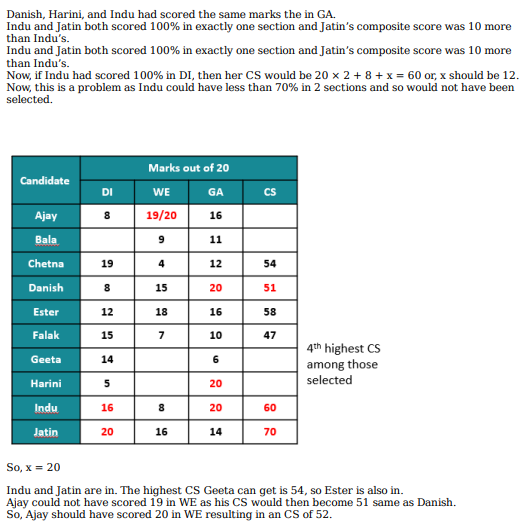
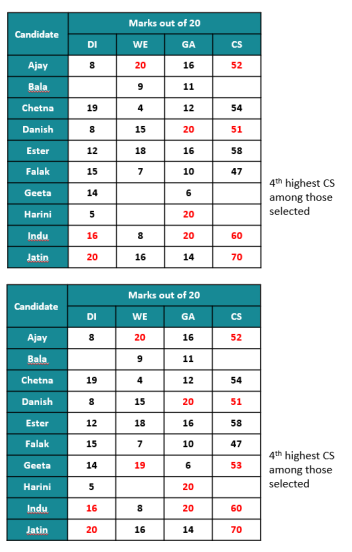

Which of the following statements MUST be FALSE?
Video Explanation

Explanatory Answer






If all the candidates scored different marks in WE then what is the maximum marks that Harini could have scored in WE? (TITA)
Video Explanation

Explanatory Answer






1600 satellites were sent up by a country for several purposes. The purposes are classified as broadcasting (B), communication (C), surveillance (S), and others (O). A satellite can serve multiple purposes; however a satellite serving either B, or C, or S does not serve O.
The following facts are known about the satellites:
1.The numbers of satellites serving B, C, and S (though may be not exclusively) are in the ratio 2:1:1.
2.The number of satellites serving all three of B, C, and S is 100.
3.The number of satellites exclusively serving C is the same as the number of satellites exclusively serving S. This number is 30% of the number of satellites exclusively serving B.
4.The number of satellites serving O is the same as the number of satellites serving both C and S but not B.
What best can be said about the number of satellites serving C?
Video Explanation

Explanatory Answer

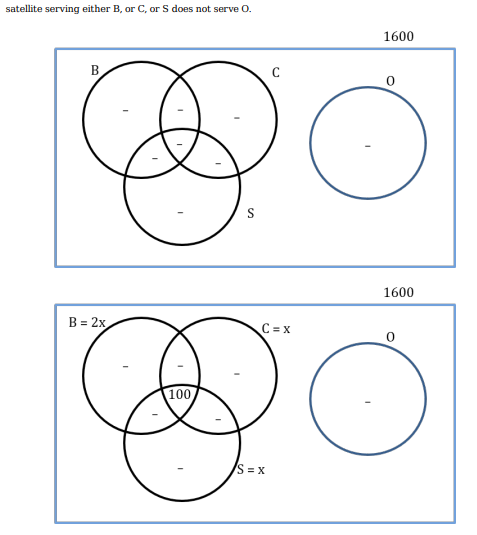
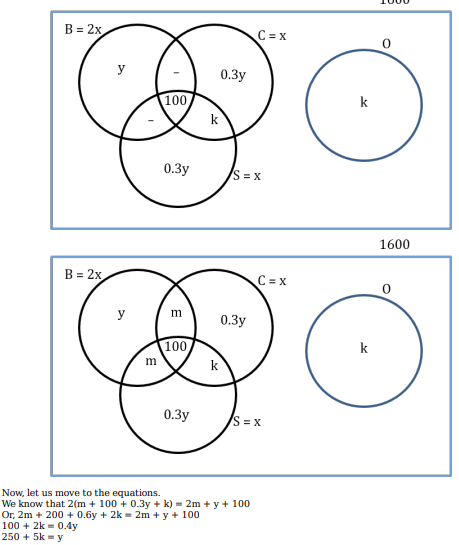
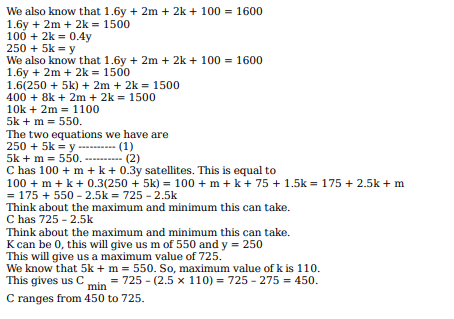
What is the minimum possible number of satellites serving B exclusively?
Video Explanation

Explanatory Answer


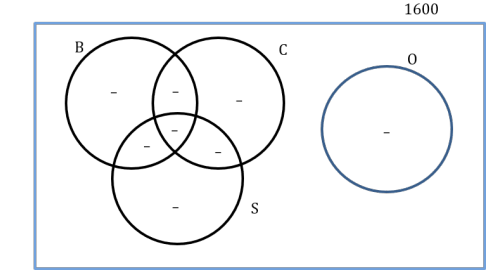
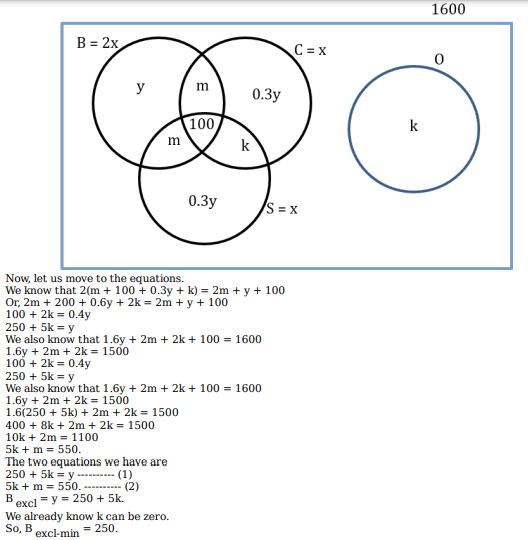
If at least 100 of the 1600 satellites were serving O, what can be said about the number of satellites serving S?
Video Explanation

Explanatory Answer


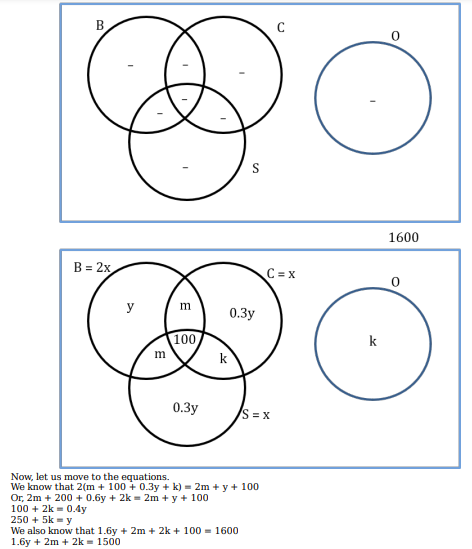
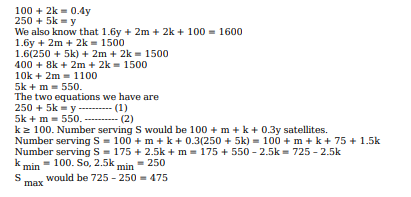
If the number of satellites serving at least two among B, C, and S is 1200, which of the following MUST be FALSE?
Video Explanation

Explanatory Answer



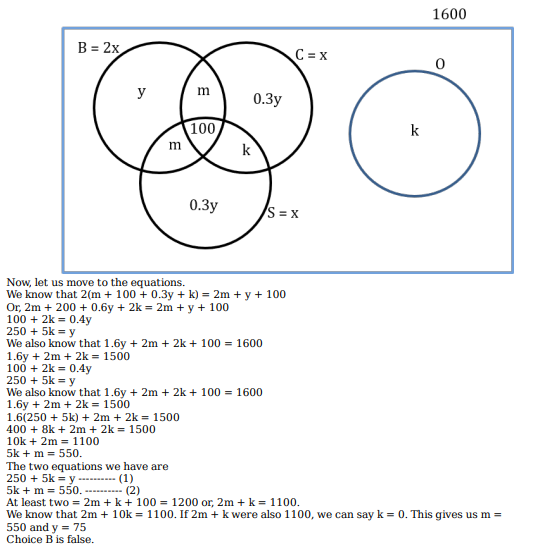
You are given an n×n square matrix to be filled with numerals so that no two adjacent cells have the same numeral. Two cells are called adjacent if they touch each other horizontally, vertically or diagonally. So a cell in one of the four corners has three cells adjacent to it, and a cell in the first or last row or column which is not in the corner has five cells adjacent to it. Any other cell has eight cells adjacent to it.
What is the minimum number of different numerals needed to fill a 3×3 square matrix? (TITA)
Video Explanation

Explanatory Answer
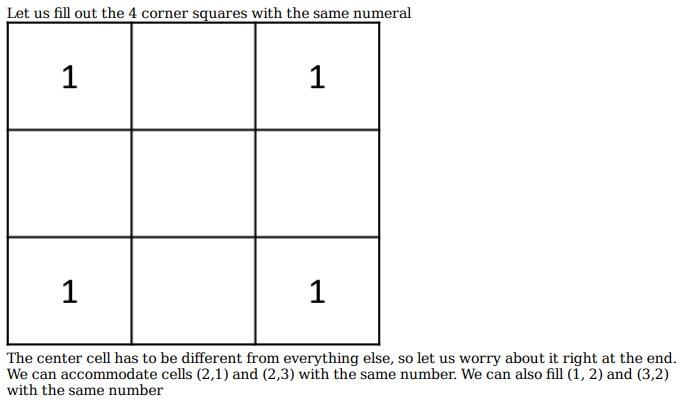
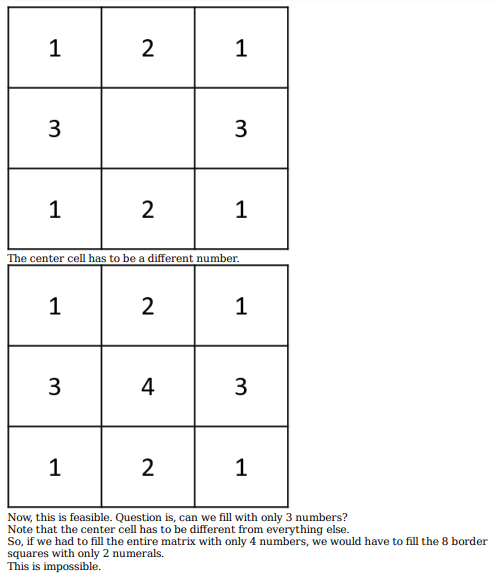
What is the minimum number of different numerals needed to fill a 5×5 square matrix? (TITA)
Video Explanation

Explanatory Answer

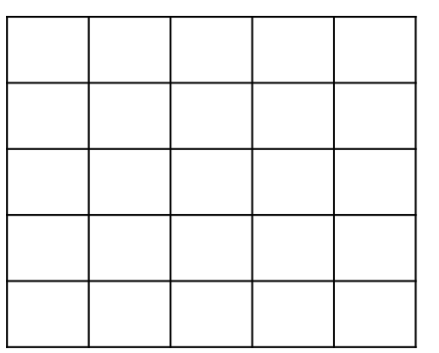
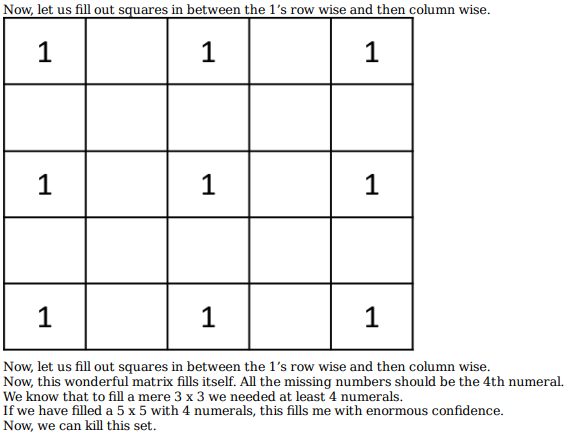
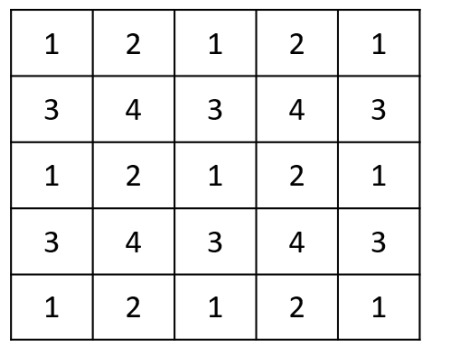
Suppose you are allowed to make one mistake, that is, one pair of adjacent cells can have the same numeral. What is the minimum number of different numerals required to fill a 5×5 matrix?
Video Explanation

Explanatory Answer
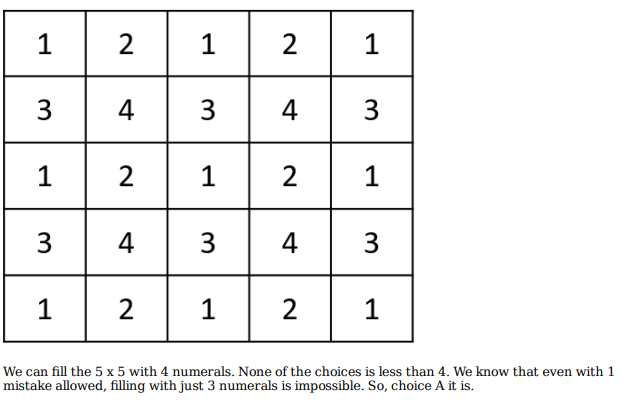
Suppose that all the cells adjacent to any particular cell must have different numerals. What is the minimum number of different numerals needed to fill a 5×5 square matrix?
Video Explanation

Explanatory Answer
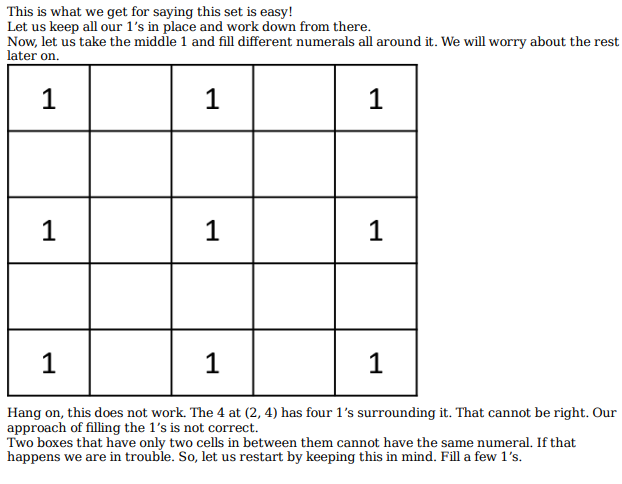
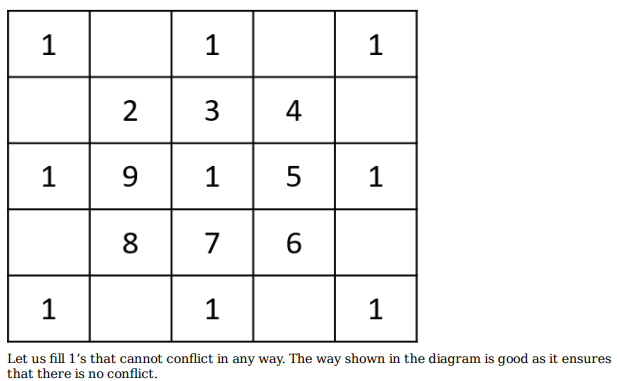
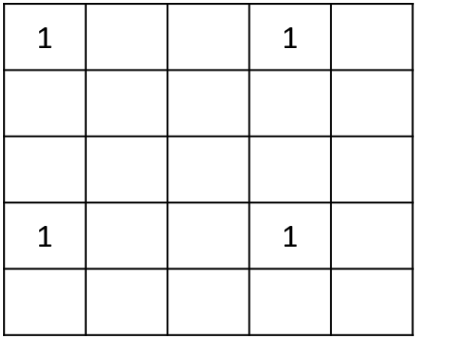
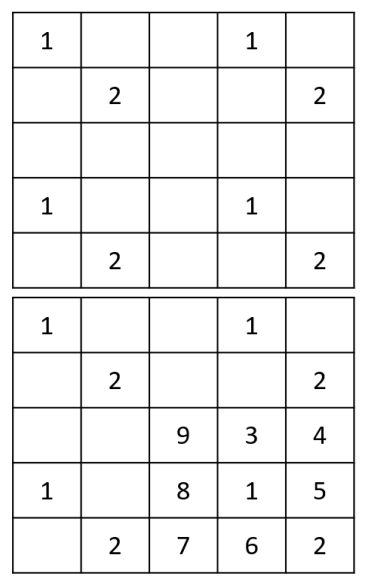
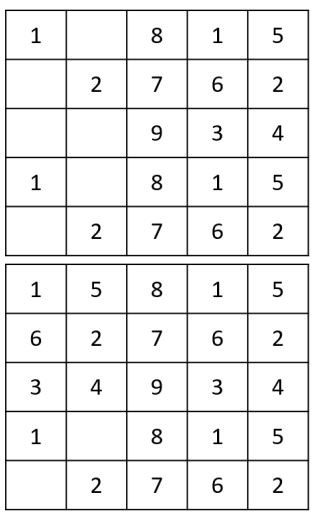
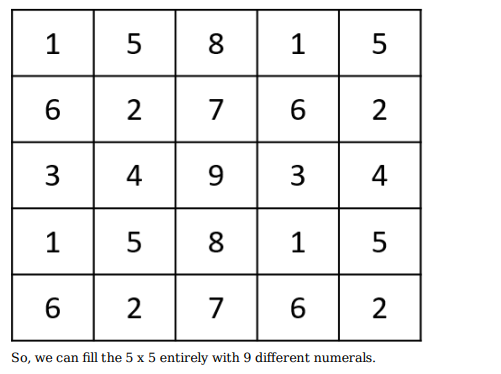


What is the percentage increase in sales in December 2017 as compared to the sales in December 2016?
Video Explanation

Explanatory Answer
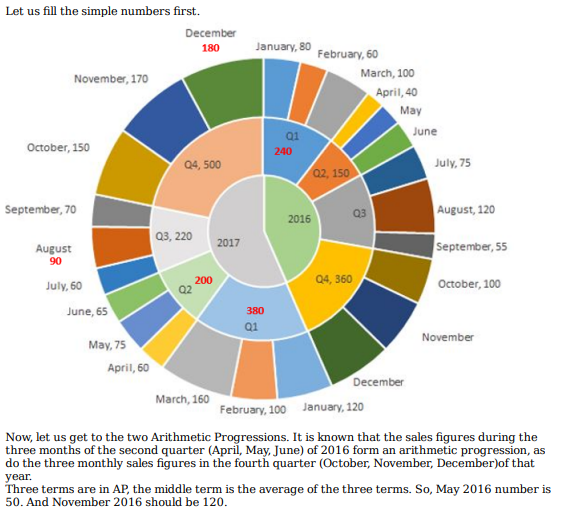
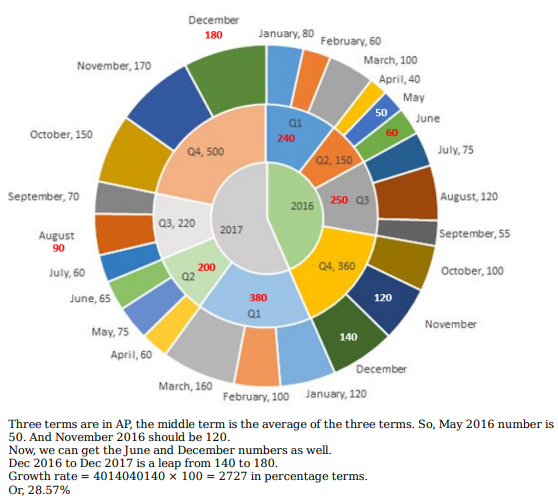
In which quarter of 2017 was the percentage increase in sales from the same quarter of 2016 the highest?
Video Explanation

Explanatory Answer
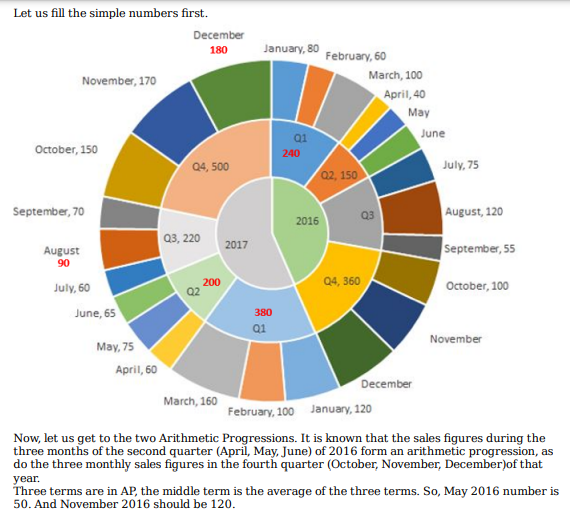

During which quarter was the percentage decrease in sales from the previous quarter’s sales the highest?
Video Explanation

Explanatory Answer

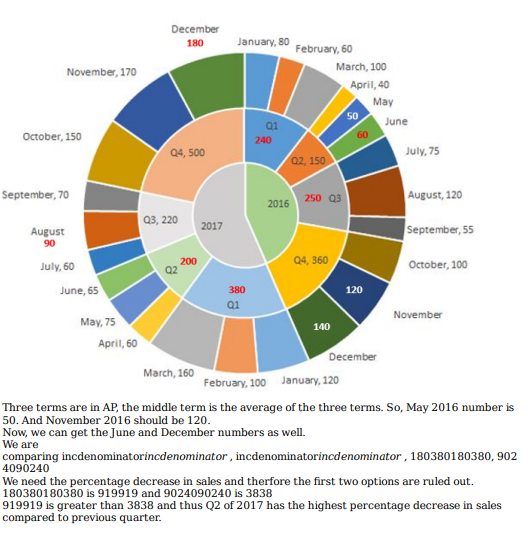
During which month was the percentage increase in sales from the previous month’s sales the highest?
Video Explanation

Explanatory Answer


An ATM dispenses exactly Rs. 5000 per withdrawal using 100, 200 and 500 rupee notes. The ATM requires every customer to give her preference for one of the three denominations of notes. It then dispenses notes such that the number of notes of the customer’s preferred denomination exceeds the total number of notes of other denominations dispensed to her.
In how many different ways can the ATM serve a customer who gives 500 rupee notes as her preference? (TITA)
Video Explanation

Explanatory Answer

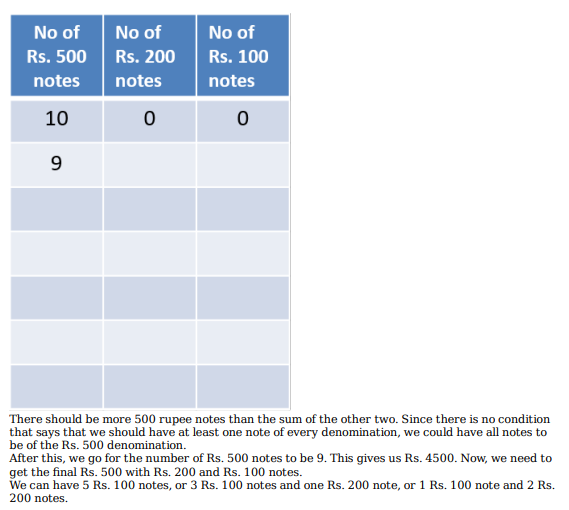
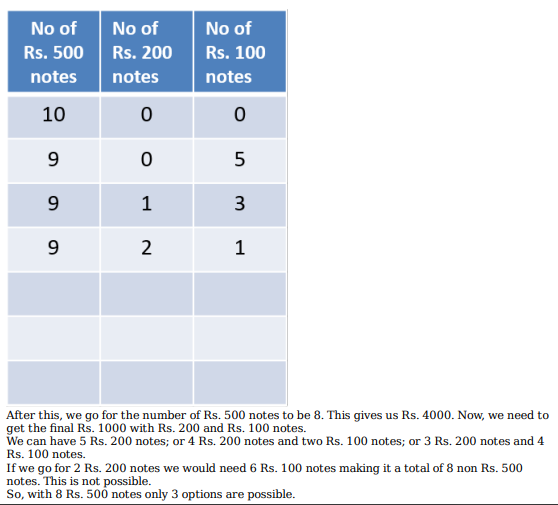
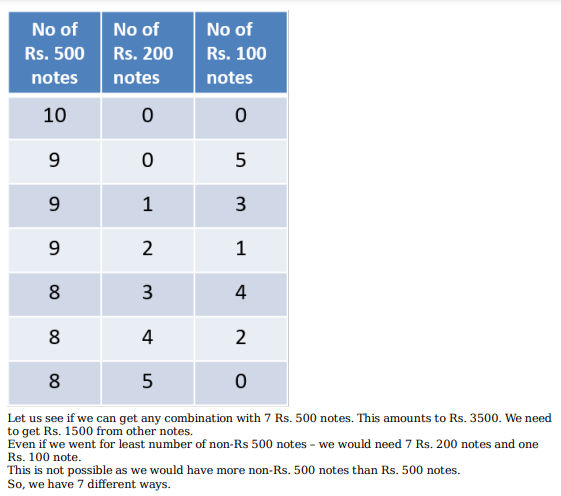
If the ATM could serve only 10 customers with a stock of fifty 500 rupee notes and a sufficient number of notes of other denominations, what is the maximum number of customers among these 10 who could have given 500 rupee notes as their preferences? (TITA)
Video Explanation

Explanatory Answer

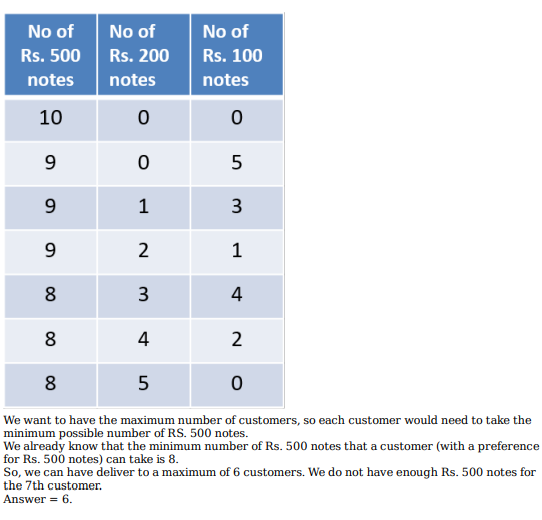
What is the maximum number of customers that the ATM can serve with a stock of fifty 500 rupee notes and a sufficient number of notes of other denominations, if all the customers are to be served with at most 20 notes per withdrawal?
Video Explanation

Explanatory Answer

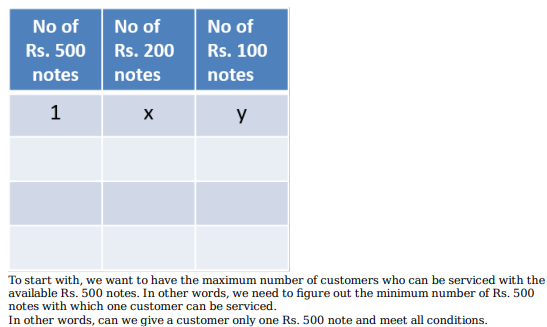
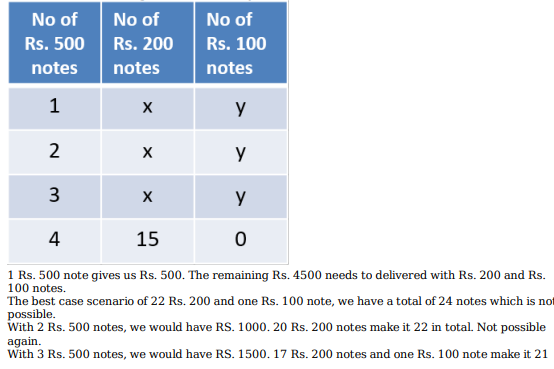

What is the number of 500 rupee notes required to serve 50 customers with 500 rupee notes as their preferences and another 50 customers with 100 rupee notes as their preferences, if the total number of notes to be dispensed is the smallest possible?
Video Explanation

Explanatory Answer
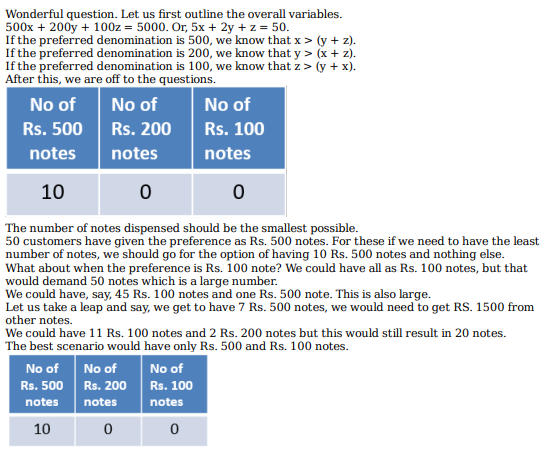

Fuel contamination levels at each of 20 petrol pumps P1, P2, …, P20 were recorded as either high, medium, or low.
1. Contamination levels at three pumps among P1 – P5 were recorded as high.
2. P6 was the only pump among P1 – P10 where the contamination level was recorded as low.
3. P7 and P8 were the only two consecutively numbered pumps where the same levels of contamination were recorded.
4. High contamination levels were not recorded at any of the pumps P16 – P20.
5. The number of pumps where high contamination levels were recorded was twice the number of pumps where low contamination levels were recorded.
Which of the following MUST be true?
Video Explanation

Explanatory Answer
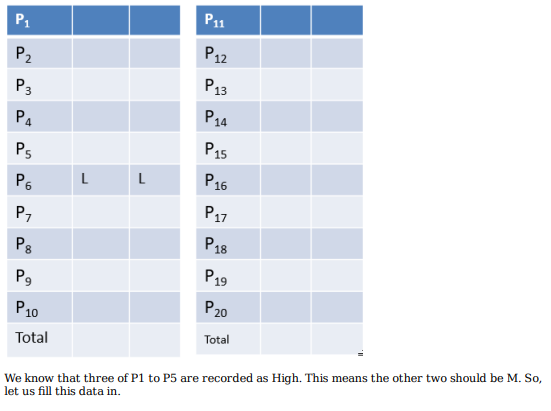
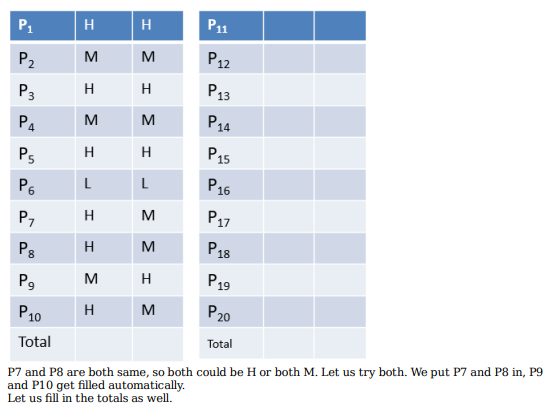

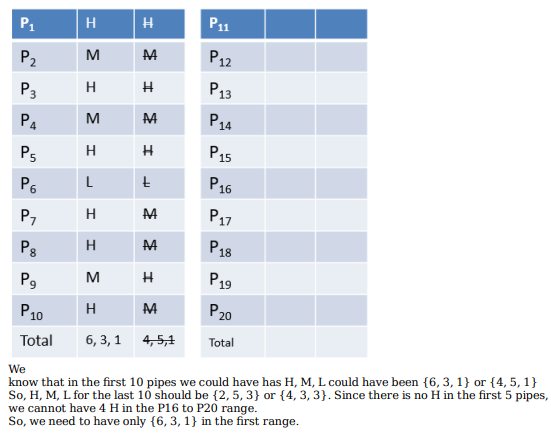
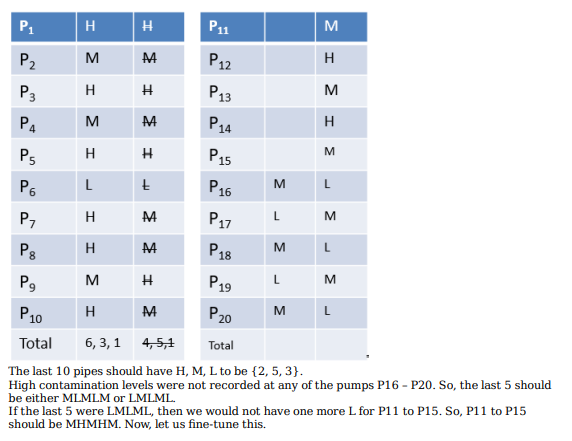
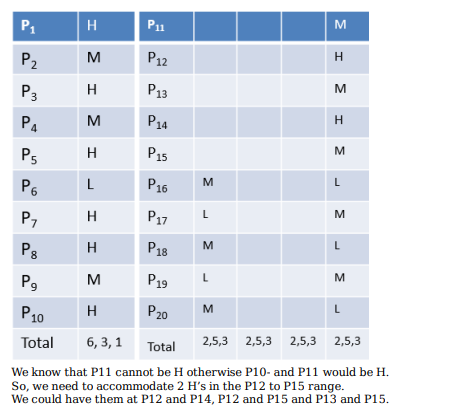
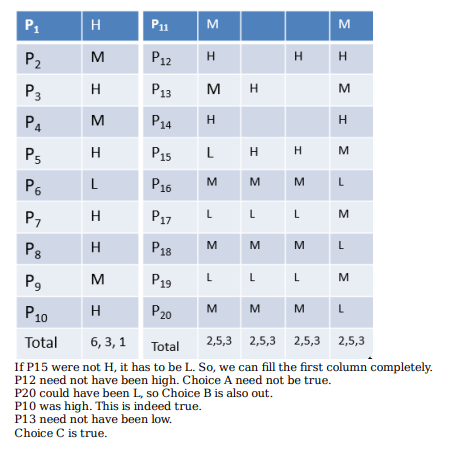
What best can be said about the number of pumps at which the contamination levels were recorded as medium?
Video Explanation

Explanatory Answer






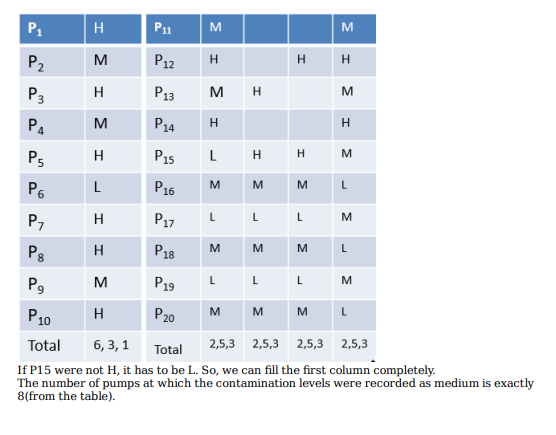
If the contamination level at P11 was recorded as low, then which of the following MUST be true?
Video Explanation

Explanatory Answer






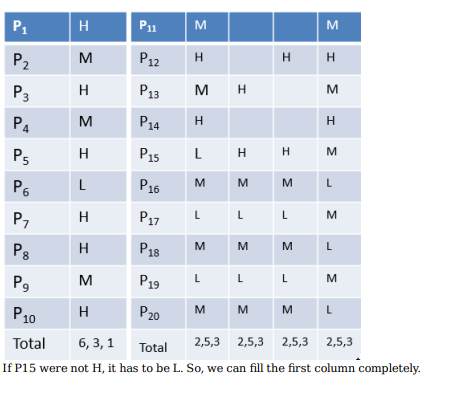
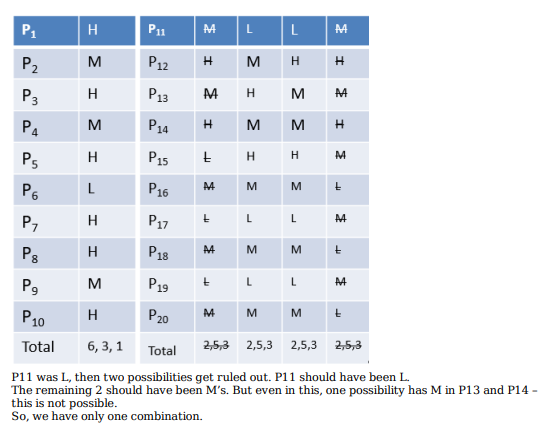
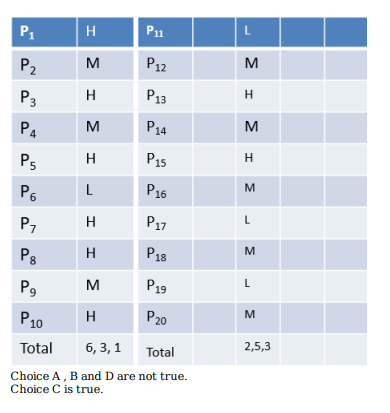
If contamination level at P15 was recorded as medium, then which of the following MUST be FALSE?
Video Explanation

Explanatory Answer







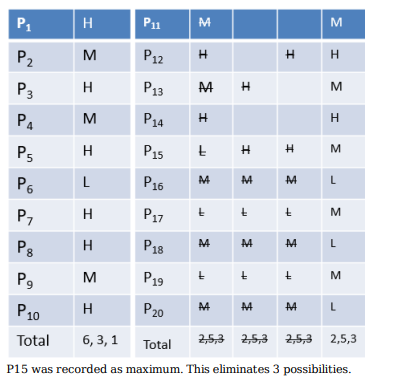
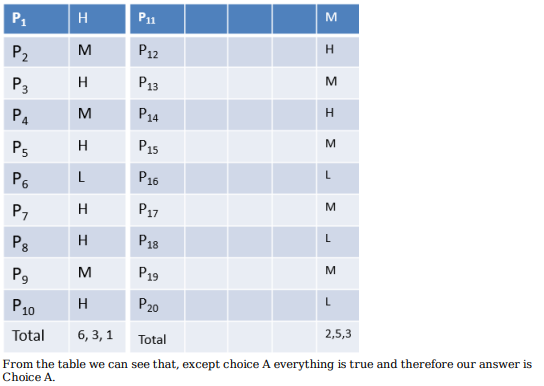
Adriana, Bandita, Chitra, and Daisy are four female students, and Amit, Barun, Chetan, and Deb are four male students. Each of them studies in one of three institutes - X, Y, and Z. Each student majors in one subject among Marketing, Operations, and Finance, and minors in a different one among these three subjects. The following facts are known about the eight students:
1. Three students are from X, three are from Y, and the remaining two students, both female, are from Z.
2. Both the male students from Y minor in Finance, while the female student from Y majors in Operations.
3. Only one male student majors in Operations, while three female students minor in Marketing.
4. One female and two male students major in Finance.
5. Adriana and Deb are from the same institute. Daisy and Amit are from the same institute.
6. Barun is from Y and majors in Operations. Chetan is from X and majors in Finance.
7. Daisy minors in Operations.
Who are the students from the institute Z?
Video Explanation

Explanatory Answer
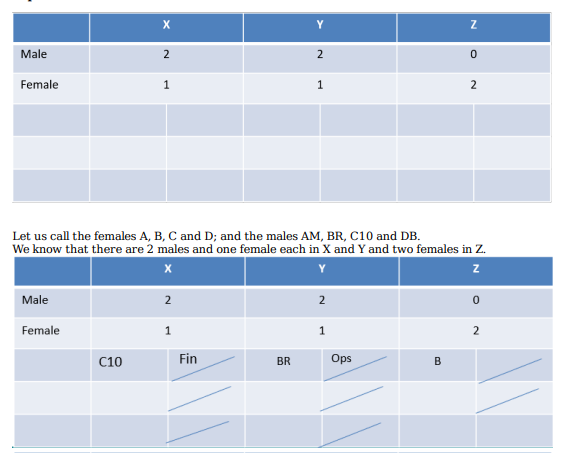
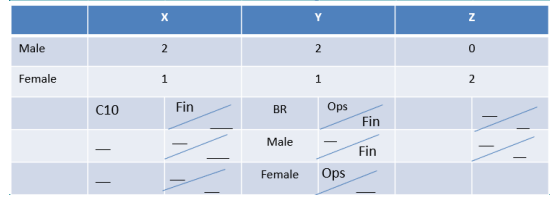
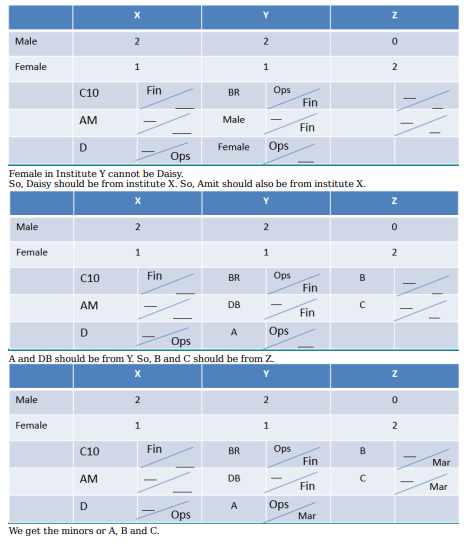
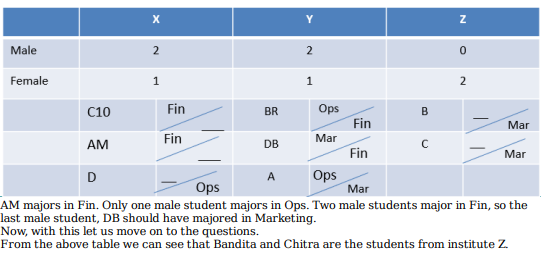
Which subject does Deb minor in?
Video Explanation

Explanatory Answer



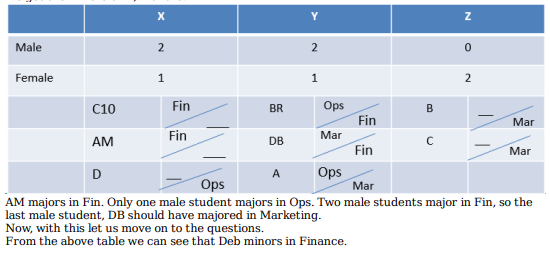
Which subject does Amit major in?
Video Explanation

Explanatory Answer



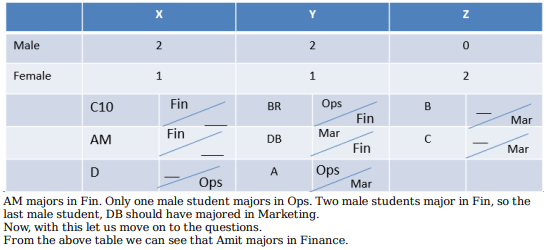
If Chitra majors in Finance, which subject does Bandita major in?
Video Explanation

Explanatory Answer



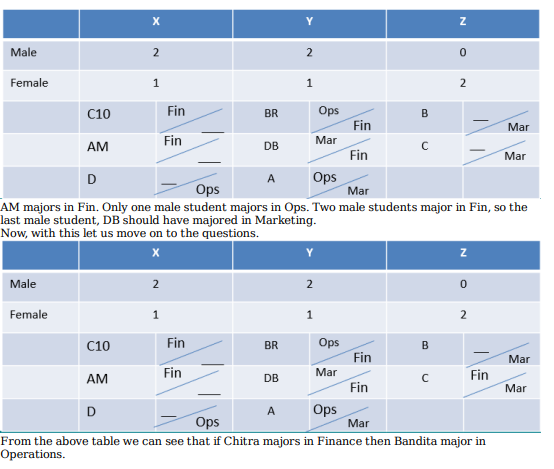
Twenty four people are part of three committees which are to look at research, teaching, and administration respectively. No two committees have any member in common. No two committees are of the same size. Each committee has three types of people: bureaucrats, educationalists, and politicians, with at least one from each of the three types in each committee. The following facts are also known about the committees:
1. The numbers of bureaucrats in the research and teaching committees are equal, while the number of bureaucrats in the research committee is 75% of the number of bureaucrats in the administration committee.
2. The number of educationalists in the teaching committee is less than the number of educationalists in the research committee. The number of educationalists in the research committee is the average of the numbers of educationalists in the other two committees.
3. 60% of the politicians are in the administration committee, and 20% are in the teaching committee.
Based on the given information, which of the following statements MUST be FALSE?
Video Explanation

Explanatory Answer
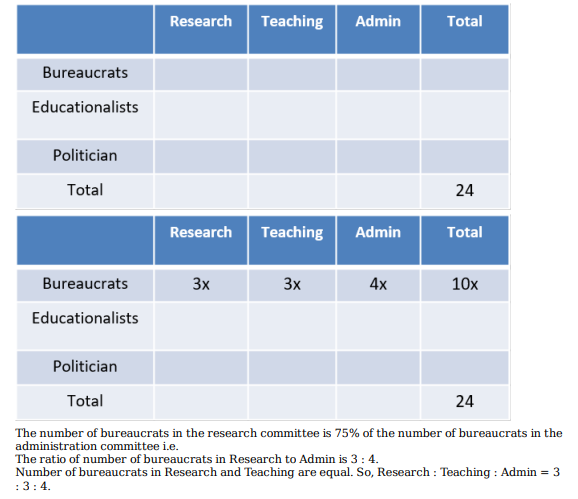
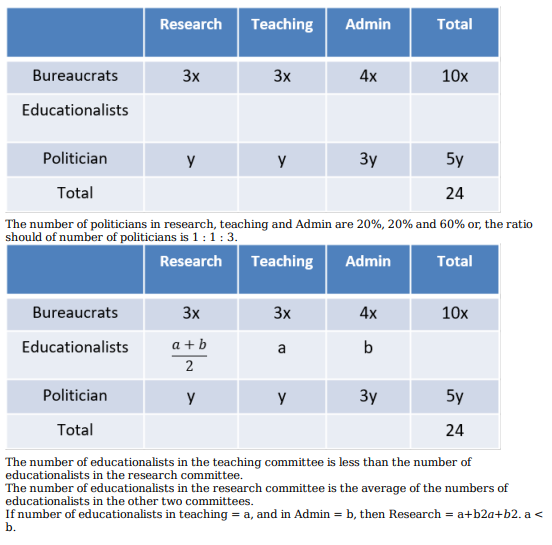
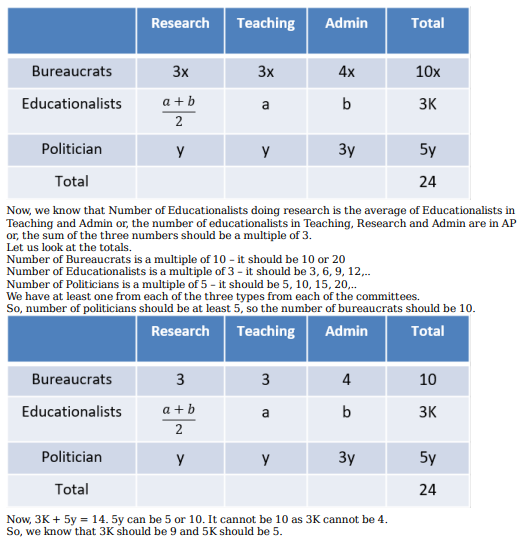
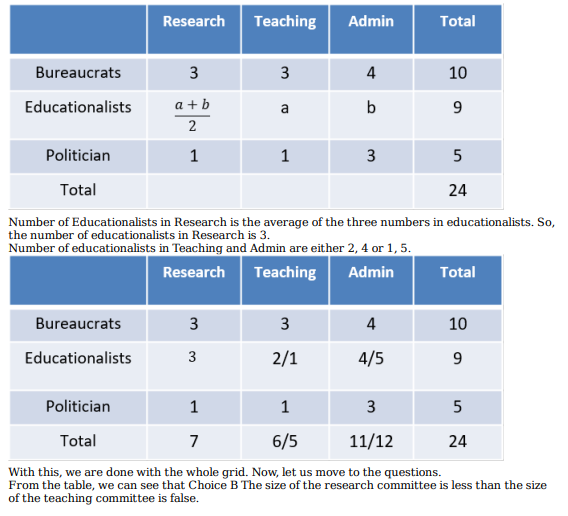
What is the number of bureaucrats in the administration committee? (TITA)
Video Explanation

Explanatory Answer



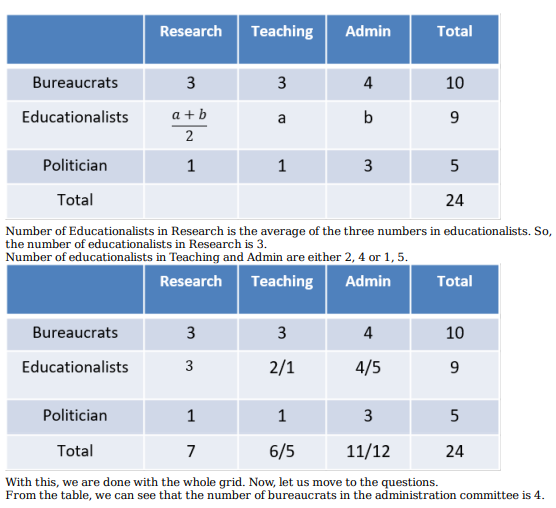
What is the number of educationalists in the research committee? (TITA)
Video Explanation

Explanatory Answer



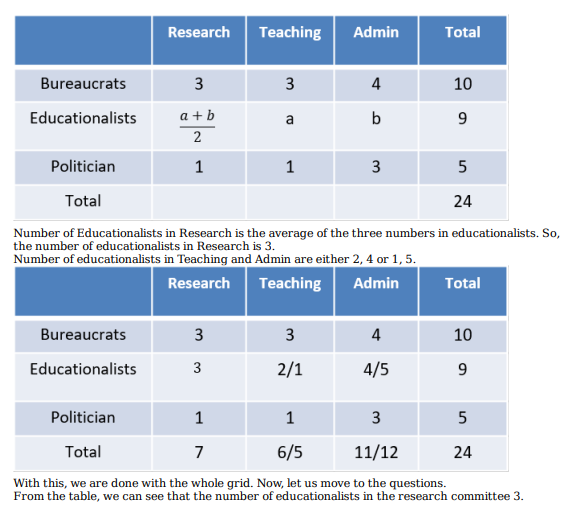
Which of the following CANNOT be determined uniquely based on the given information?
Video Explanation

Explanatory Answer



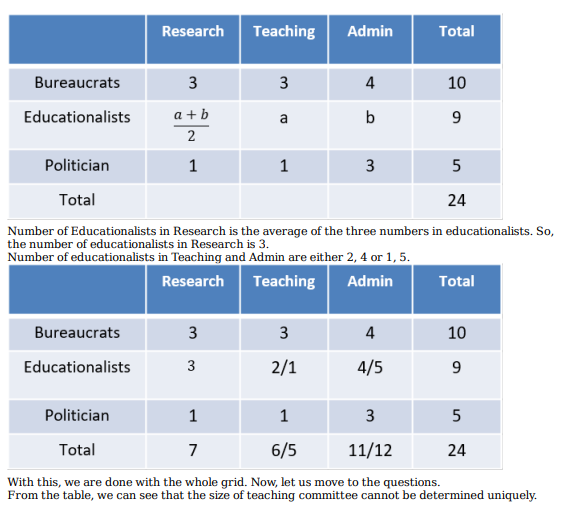
A trader sells 10 litres of a mixture of paints A and B, where the amount of B in the mixture does not exceed that of A. The cost of paint A per litre is Rs. 8 more than that of paint B. If the trader sells the entire mixture for Rs. 264 and makes a profit of 10%, then the highest possible cost of paint B, in Rs. per litre, is
Video Explanation

Explanatory Answer
Given, The amount of B in mixture ≤ Amount of A in mixture
Selling Price = Rs. 264 and Profit = 10 %
264 = 1.1 × CP
CP = 264/1.1 = Rs. 240 for 10 litres
CP per litre = Rs. 24
We also know that, CP per litre of A = CP per litre of B + 8 Let CP per litre of B = x So, CP per
litre of A = x + 8
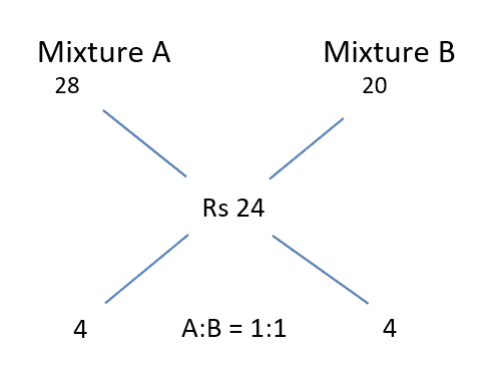
Given Amount of B ≤ Amount of A,
Maximum possible cost of B occurs when B = A
We need to choose values for A and B in such a way that the quantities remain same.But A should
be 8 more than B
Therefore, A should have a CP per litre of Rs. 28 and B should have a CP per litre of Rs 20
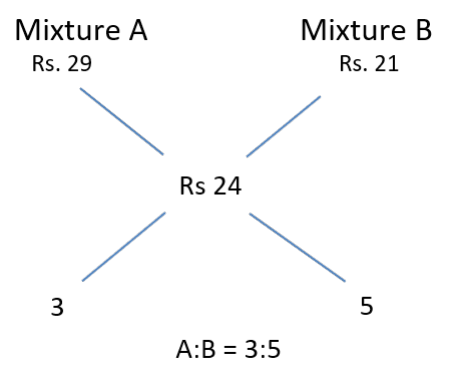
B cannot be assigned any more than this as the amount of B would become more than A
Example: Let us assign B to be Rs. 21 and A to be Rs. 29 which would result in a ratio of 3:5 where
B amounts more than A, which doesn’t satisfy the condition
Max possible cost of Paint B = Rs. 20 per litre
In a circle with centre O and radius 1 cm, an arc AB makes an angle 60 degrees at O. Let R be the region bounded by the radii OA, OB and the arc AB. If C and D are two points on OA and OB, respectively, such that OC = OD and the area of triangle OCD is half that of R, then the length of OC, in cm, is
Video Explanation

Explanatory Answer
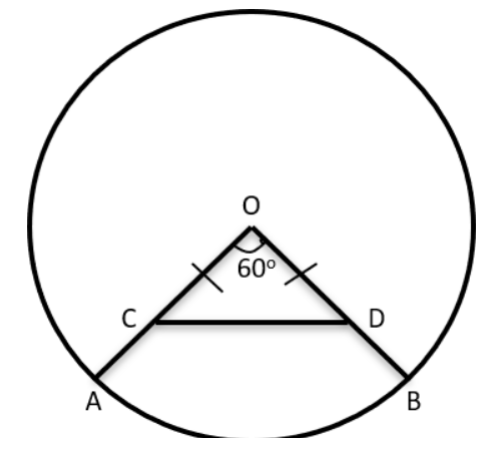
Given ∠AOB = 60°
Area of Sector AOB = 60/360 × π = π/6 ---(1)
Given OC = OD => ∠OCD = ∠ODC = 60°
△OCD is an Equilateral Triangle with side = a
Area(△OCD) = √3/4 × a × a ---(2)
Its given that Area(OCD) = 1/2 × Area(OAB)
a 2 (√3/4) = π / ( 6×2)
a = (π/ 3√3) 1/2
If f(x + 2) = f(x) + f(x + 1) for all positive integers x, and f(11) = 91, f(15) = 617, then f(10) equals.
Video Explanation

Explanatory Answer
Given, f(x+2) = f(x) + f(x+1) f(11) = 91, f(15) = 617
We get 91 + f(12) = f(13)
Let f(12) be equal to some value ‘a’
So, 91 + a = f(13).
f(12) + f(13) = f(14)
a + 91 + a = f(14)
So, f(14) = 2a + 91 f(13) + f(14) = 617
So, 91 + a + 2a + 91 = 617
3a + 182 = 617
a = 145
Substituting the value of a and f(11), we get
f(10)+ 91 = 145
f(10) = 54
The distance from A to B is 60 km. Partha and Narayan start from A at the same time and move towards B. Partha takes four hours more than Narayan to reach B. Moreover, Partha reaches the mid-point of A and B two hours before Narayan reaches B. The speed of Partha, in km per hour, is
Video Explanation

Explanatory Answer
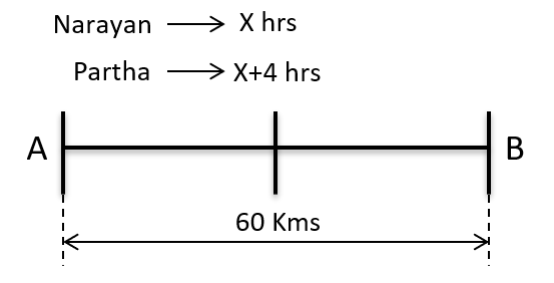
Let Narayanan take X hrs to reach B then Partha would take X + 4 hrs
Its given that Partha reaches the mid-point of A and B two hours before Narayan reaches B
X+4 / 2 = X – 2 => X=8 hrs
So, Partha would take 8+4 = 12 hrs to travel 60 Kms at a speed of 60/12 Kmph
Speed of Partha = 5 Kmph
A CAT aspirant appears for a certain number of tests. His average score increases by 1 if the first 10 tests are not considered, and decreases by 1 if the last 10 tests are not considered. If his average scores for the first 10 and the last 10 tests are 20 and 30, respectively, then the total number of tests taken by him is
Video Explanation

Explanatory Answer
Let there be 'n' tests and the Overall Average score be k
Average (n) = k => Total marks = nk
So, when we ignore the first 10 questions,
Average (n-10) = k+1
Similarly, if we ignore the last 10 questions,
Average (first (n-10)) = k-1
It is given that when the first 10 tests are not considered, the overall average increases by 1
(Each question carries 20 marks)
Total marks – 20×10 = (k+1) (n-10)
kn – 200 = (k+1) (n-10) ---(1)
Similarly, If the last 10 tests are not considered, the overall average decreases by 1 (Each
question carries 30 marks)
kn - 300 = (k-1) (n-10) ---(2)
Solving (1) and (2), we get
kn - 200 = (k+1) (n-10)
(-) kn - 300 = (k-1) (n-10)
-------------------------------------
100 = 2(n-10)
50 = n-10
n = 60 questions
Two types of tea, A and B, are mixed and then sold at Rs. 40 per kg. The profit is 10% if A and B are mixed in the ratio 3 : 2, and 5% if this ratio is 2 : 3. The cost prices, per kg, of A and B are in the ratio
Video Explanation

Explanatory Answer
Let Tea A and B be sold at Rs.a and Rs.b respectively
When A and B are mixed in the ratio 3 : 2 and sold at a profit of 10% at Rs.40 per Kg
3a+2b / 5 = 40/1.1------(1)
When A and B are mixed in the ratio 2 : 3 and sold at a profit of 5% at Rs.40 per Kg
2a+3b/5 = 40/1.05 ------(2)
Solving equations (1) and (2), we get
1.1 × (3a+2b/5) = 1.05 × (2a+3b/5)
11/10 × (3a + 2b) = 21/20 × (2a + 3b)
66a + 44b = 42a + 63b
24a = 19b
a/b = 19/24
So, the cost prices per Kg of A and B are in the ratio 19 : 24
A wholesaler bought walnuts and peanuts, the price of walnut per kg being thrice that of peanut per kg. He then sold 8 kg of peanuts at a profit of 10% and 16 kg of walnuts at a profit of 20% to a shopkeeper. However, the shopkeeper lost 5 kg of walnuts and 3 kg of peanuts in transit. He then mixed the remaining nuts and sold the mixture at Rs. 166 per kg, thus making an overall profit of 25%. At what price, in Rs. per kg, did the wholesaler buy the walnuts?
Video Explanation

Explanatory Answer
Let the wholesaler bought walnuts and peanuts at Rs 3x and Rs x respectively
He sold 8kgs of Peanuts to the shopkeeper at 10% Profit
Cost price of the Peanuts bought by the shopkeeper = Rs. 1.1x per kg
Similarly, he sold 16 kgs of Walnuts to the shopkeeper at 20% Profit
Cost price of the Walnuts bought by the shopkeeper = 1.2 × 3x = Rs. 3.6x per Kg
He lost 5 kgs of Walnuts and 3 Kgs of Peanuts in transit
Remaining = 16 - 5 = 11 kgs of Walnuts & 8-3 = 5 kgs of Peanuts
He mixes them together and sells them at Rs. 166 per kg, making an overall Profit of 25%
Selling Price = 5/4 × Cost Price
Overall Cost Price = Rs.(3.6 × 16x + 1.1 × 8x)
Overall Selling Price = Rs. 16 × 166
Overall Selling Price = 5/4 × Overall Cost Price
(3.6 × 16x + 1.1 × 8x) × 5/4 = 16 × 166
( ( 57.6 × 8.8) x ) × 5/4 = 16 × 166
x = Rs. 32
Cost price per Kg of Walnuts bought by the Wholesaler = Rs. 3x = 3 × 32 = >Rs. 96
When they work alone, B needs 25% more time to finish a job than A does. They two finish the job in 13 days in the following manner: A works alone till half the job is done, then A and B work together for four days, and finally B works alone to complete the remaining 5% of the job. In how many days can B alone finish the entire job?
Video Explanation

Explanatory Answer
Its given that B needs 25% more time than A
So, if Time taken by A = 4x days, Time taken by B = 5x days
A does half the work, So A works alone for 2x days --- (1)
A and B work for 4 days --- (2)
B works alone for 5x/20= x/4 days --- (3)
Total working days = 13
(1) + (2) + (3) = 13
2x + 4 + x/4 = 13 we get, x = 4
So, B alone can do the work in 5 × 4 = 20 days
Hence, the answer is 20 days
Given an equilateral triangle T1 with side 24 cm, a second triangle T2 is formed by joining the midpoints of the sides of T1. Then a third triangle T3 is formed by joining the midpoints of the sides of T2. If this process of forming triangles is continued, the sum of the areas, in sq cm, of infinitely many such triangles T1, T2, T3,. will be
Video Explanation

Explanatory Answer
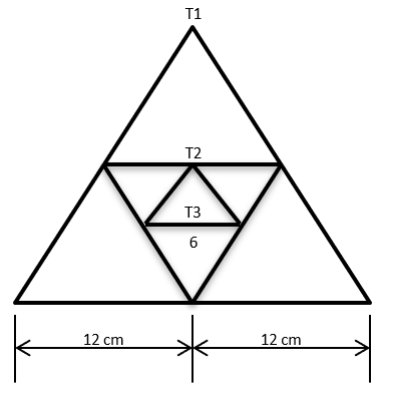
As the triangle progresses infinitely and the side length decreases, it follows an infinite GP series
As the sides decrease by half, their areas decrease by 1/4
We know, Area of an Equilateral Triangle = √3/4 × a 2
Area of T1 = √3/4 × 24 × 24 = 144 √3 sq cms
Sum of an Infinite GP = a / 1−r where a = 144 √3 , r = 1/4
Sum of areas ( T1, T2, T3,) = 144√3 / {1−(1/4)} = 4×144√3 / 3
Therefore, Sum of areas= 192 √3 sq cms.
While multiplying three real numbers, Ashok took one of the numbers as 73 instead of 37. As a result, the product went up by 720. Then the minimum possible value of the sum of squares of the other two numbers is:
Video Explanation

Explanatory Answer
Let the three real numbers be a, b, c. c is taken as 73 instead of 37
So, 73ab = 37ab + 720
36 ab = 720
ab = 720/36 = 20
We know, AM ≥ GM
(a²+b²) / 2 ≥ ab
(a 2 + b 2 ) ≥ 2ab
(a 2 + b 2 ) ≥ 40
(Or)
ab = 20
(a,b) = (√20, √20)
(a 2 + b 2 ) = 20 + 20 = 40
If x is a positive quantity such that 2x = 3log52 , then x is equal to
Video Explanation

Explanatory Answer
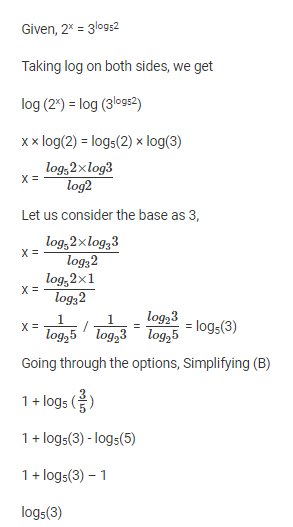
A right circular cone, of height 12 ft, stands on its base which has diameter 8 ft. The tip of the cone is cut off with a plane which is parallel to the base and 9 ft from the base. With π = 22/7, the volume, in cubic ft, of the remaining part of the cone is:
Video Explanation

Explanatory Answer
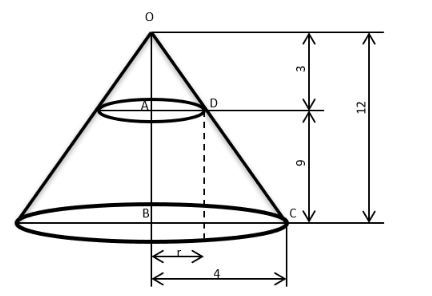
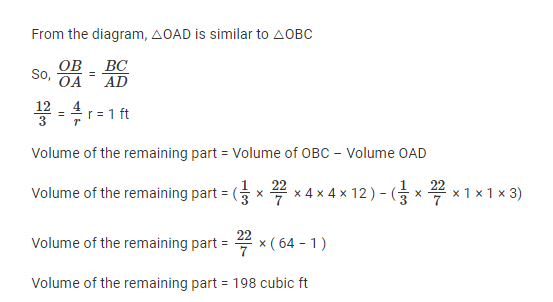
How many numbers with two or more digits can be formed with the digits 1, 2, 3, 4, 5, 6, 7, 8, and 9 so that in every such number, each digit is used at most once and the digits appear in the ascending order?
Video Explanation

Explanatory Answer

John borrowed Rs. 2,10,000 from a bank at an interest rate of 10% per annum, compounded annually. The loan was repaid in two equal instalments, the first after one year and the second after another year. The first instalment was interest of one year plus part of the principal amount, while the second was the rest of the principal amount plus due interest thereon. Then each instalment, in Rs., is:
Video Explanation

Explanatory Answer
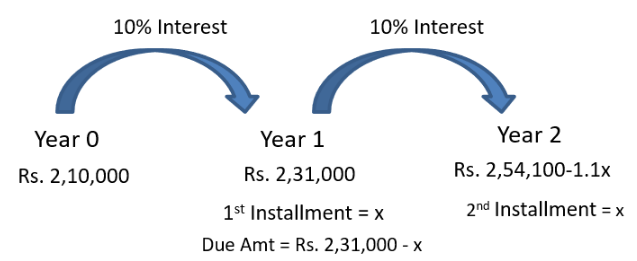

If u2 + (u−2v−1)2 = −4v(u + v), then what is the value of u + 3v?
Video Explanation

Explanatory Answer
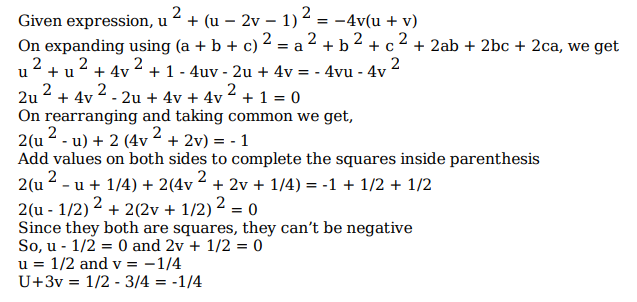
Point P lies between points A and B such that the length of BP is thrice that of AP. Car 1 starts from A and moves towards B. Simultaneously, car 2 starts from B and moves towards A. Car 2 reaches P one hour after car 1 reaches P. If the speed of car 2 is half that of car 1, then the time, in minutes, taken by car 1 in reaching P from A is:
Video Explanation

Explanatory Answer

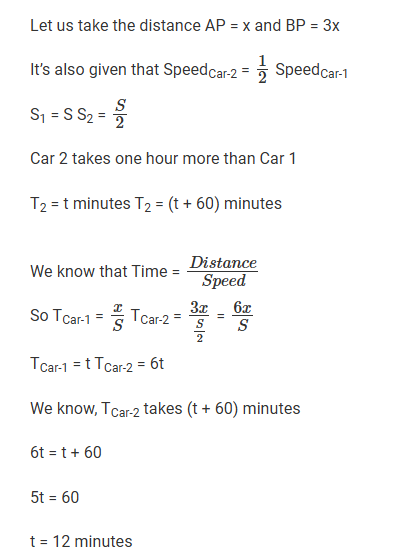
Let ABCD be a rectangle inscribed in a circle of radius 13 cm. Which one of the following pairs can represent, in cm, the possible length and breadth of ABCD?
Video Explanation

Explanatory Answer
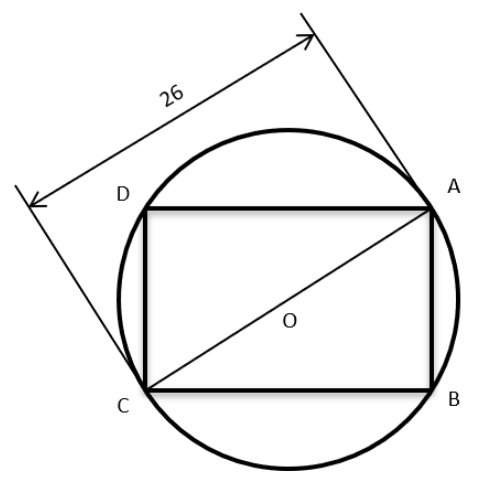
Since, ABCD is a rectangle inscribed inside a circle
ABC must be a Right triangle
Given that radius of Circle = 13 cms
5, 12, 13 forms a Pythagorean Triplet
10, 24, 26 is also a Pythagorean triplet
So, 10 and 24 are possible length and breadth of ABCD
In an examination, the maximum possible score is N while the pass mark is 45% of N. A candidate obtains 36 marks, but falls short of the pass mark by 68%. Which one of the following is then correct?
Video Explanation

Explanatory Answer
Given Max. mark = N and Pass mark = 45% of N
A scores 36 marks and falls short of the pass mark by 68%
This means the pass mark must be reduced by (100 - 68)% = 32%
So, A scored 32% (45% N) = 36
N = 250 marks
The only option whose range falls within the obtained value is (B) 243 ≤ N ≤ 252
Let x, y, z be three positive real numbers in a geometric progression such that x < y < z. If 5x, 16y, and 12z are in an arithmetic progression then the common ratio of the geometric progression is
Video Explanation

Explanatory Answer


The number of integers x such that 0.25 < 2x < 200, and 2x + 2 is perfectly divisible by either 3 or 4, is
Video Explanation

Explanatory Answer
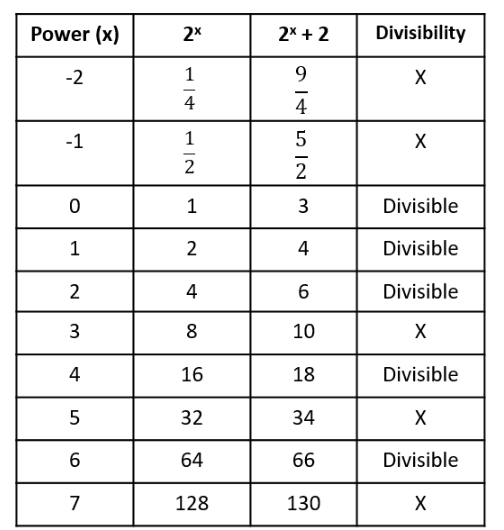

Each of 74 students in a class studies at least one of the three subjects H, E and P. Ten students study all three subjects, while twenty study H and E, but not P. Every student who studies P also studies H or E or both. If the number of students studying H equals that studying E, then the number of students studying H is
Video Explanation

Explanatory Answer
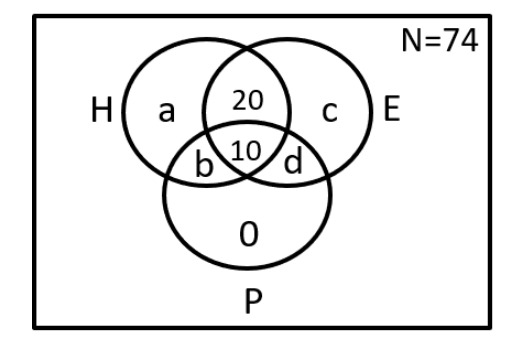
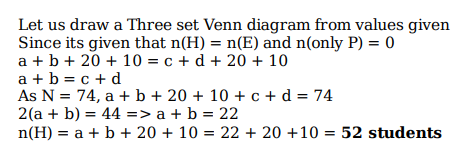
Train T leaves station X for station Y at 3 pm. Train S, traveling at three quarters of the speed of T, leaves Y for X at 4 pm. The two trains pass each other at a station Z, where the distance between X and Z is three-fifths of that between X and Y. How many hours does train T take for its journey from X to Y?
Video Explanation

Explanatory Answer

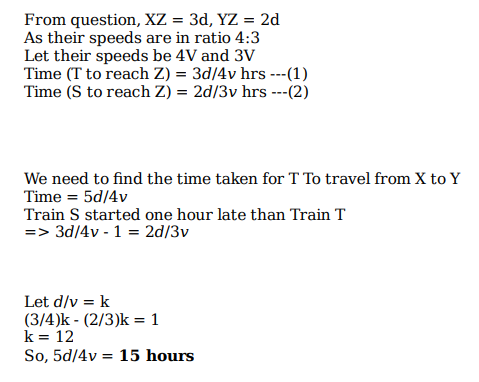
Points E, F, G, H lie on the sides AB, BC, CD, and DA, respectively, of a square ABCD. If EFGH is also a square whose area is 62.5% of that of ABCD and CG is longer than EB, then the ratio of length of EB to that of CG is:
Video Explanation

Explanatory Answer
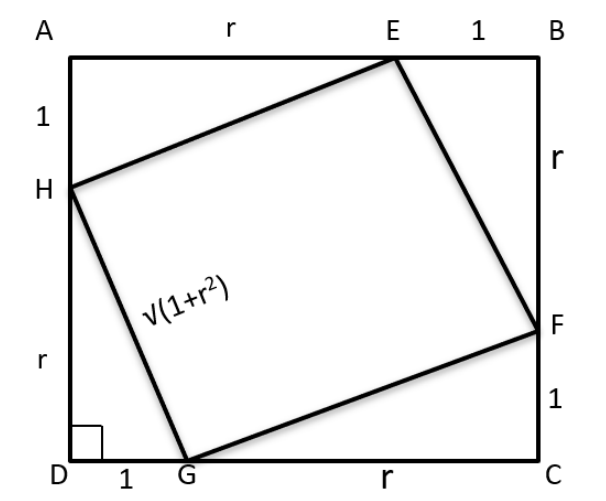
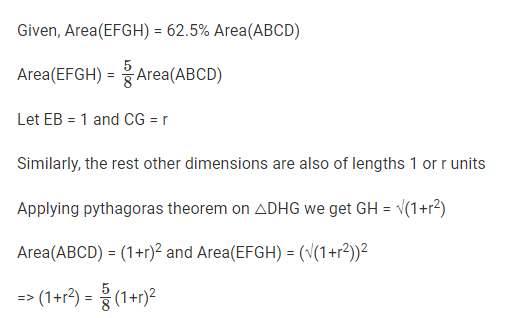
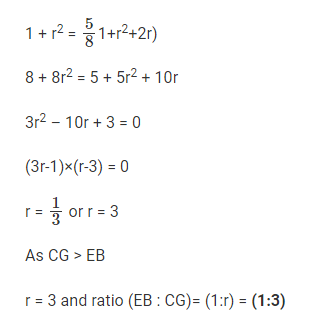
Given that x2018 y2017 = 1/2 and x2016 y2019 = 8, the value of x2 + y3 is
Video Explanation

Explanatory Answer
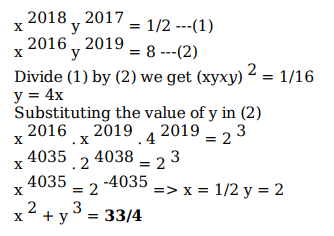
Raju and Lalitha originally had marbles in the ratio 4 : 9. Then Lalitha gave some of her marbles to Raju. As a result, the ratio of the number of marbles with Raju to that with Lalitha became 5 : 6. What fraction of her original number of marbles was given by Lalitha to Raju?
Video Explanation

Explanatory Answer
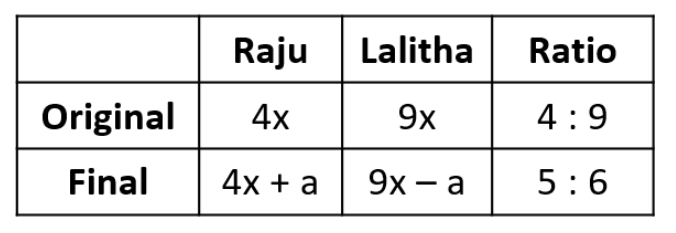
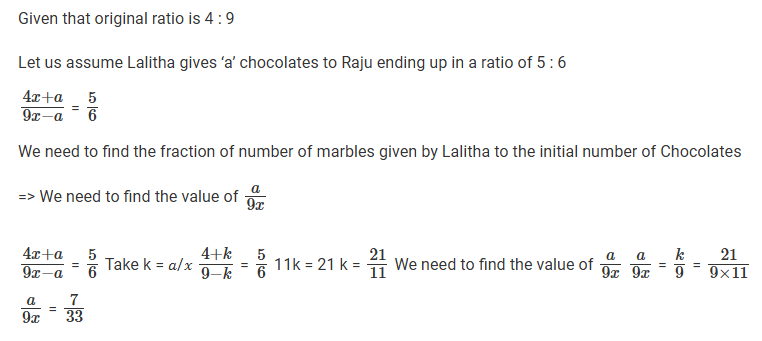
If log2(5 + log3a) = 3 and log5(4a + 12 + log2b) = 3, then a + b is equal to
Video Explanation

Explanatory Answer
